Marc Tyler Nobleman's Blog, page 53
March 8, 2016
Last stop in Asia: Hong Kong
My month-long school visit trip to Asia (2/13-3/11/16) has been a series of adventures and puddle-jumping flights between them:
2/23/16 Kuala Lumpur to Phuket2/29/16 Phuket to Kuala Lumpur3/1/16 Kuala Lumpur to Phuket3/3/16 Phuket to Chiang Mai3/5/16 Chiang Mai to Hong Kong
A day after I walked with elephants in rural Thailand, I was in the middle of the high-rise city of Hong Kong, where I've come to speak at four international schools. I've learned that I prefer learning about a city once I'm in it; prior to being here, my knowledge of Hong Kong was barely even this:

Hong Kong: where airport staff made me take off my baseball hat five minutes before I reached immigration but did not care when I told them that someone left two plastic bags on the floor in line at immigration.
Within hours after arriving, after a nap to compensate for my 3:30 a.m. wake-up to make my 6 a.m. flight from Thailand, I was on the ferry from Hong Kong Island to Kowloon on the mainland.
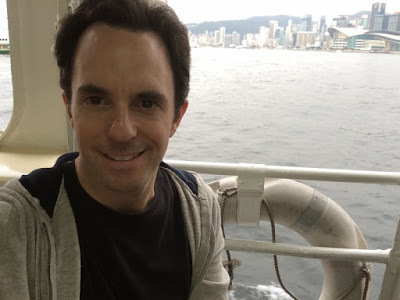
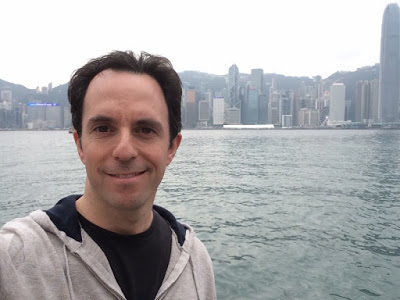
Other sights from my wanderings:
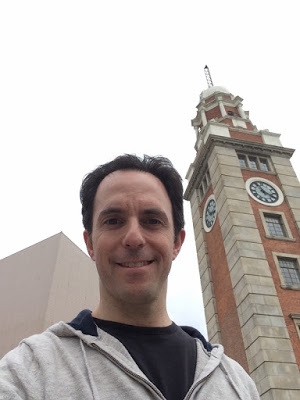
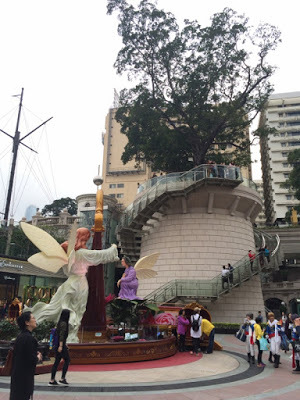
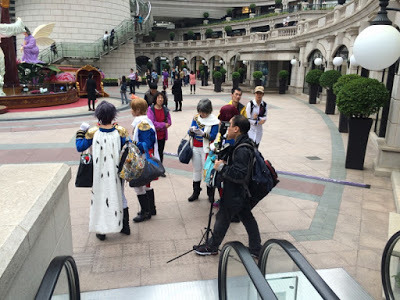
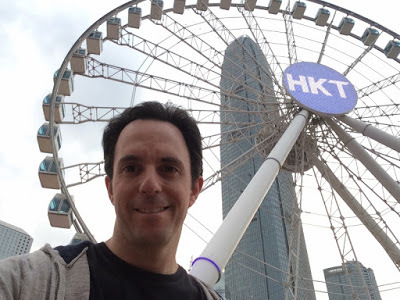
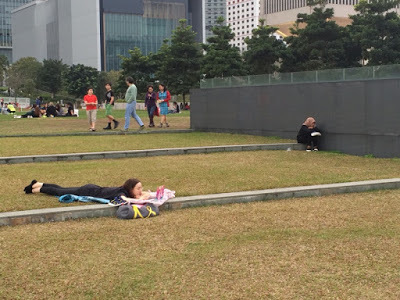
Hong Kong junk:
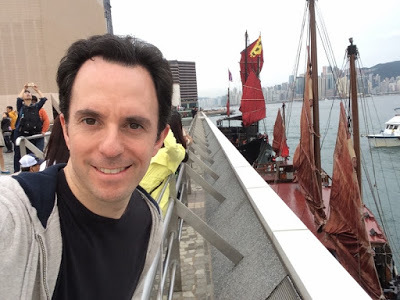
Ball in the air:
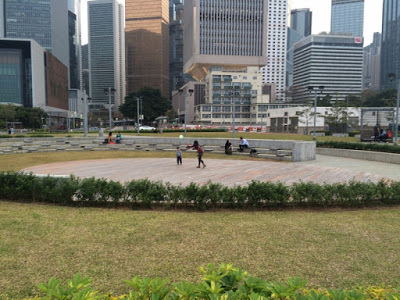
The following day, I took on the Twin Peaks; at 3,000 steps (though they say 1,000), it's a workout with a view. And it's actually three peaks; the first is called Violet Hill. You start right behind here, a complex that looks cool but doesn't seem in close proximity to rolling hills:
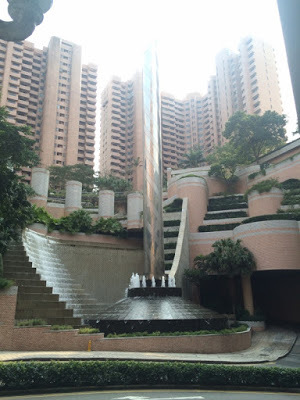
The first part of the climb:
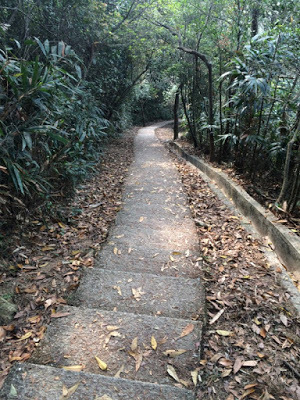
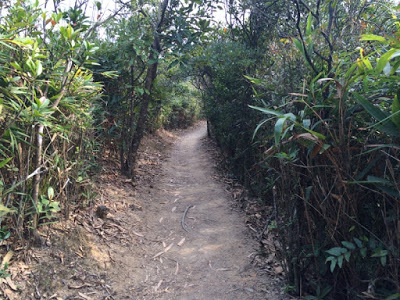
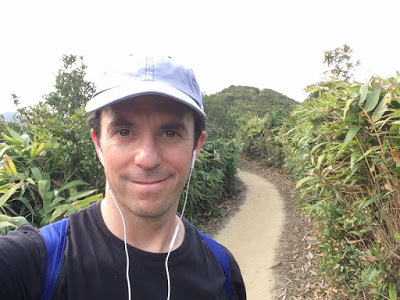
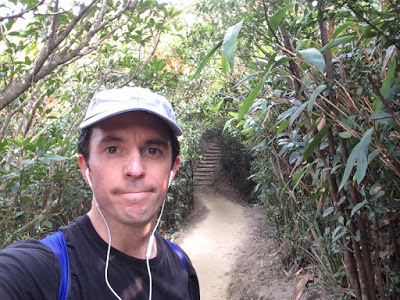
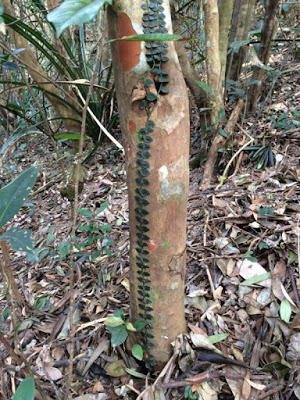
Remember that building I started at?
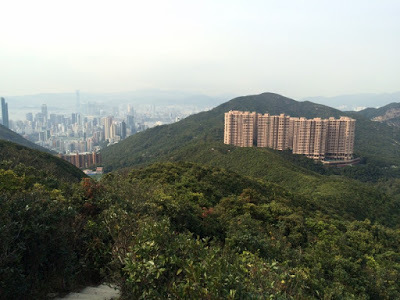
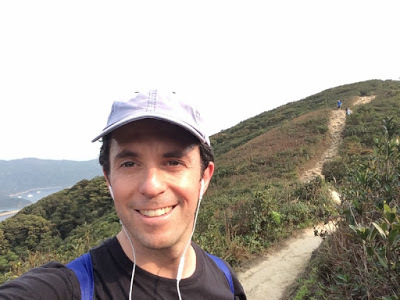

Pretty but precarious:
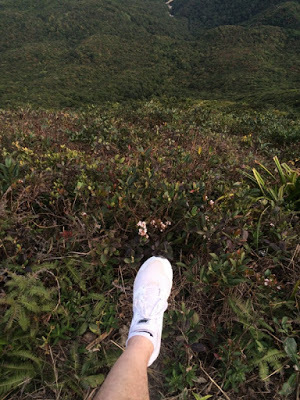
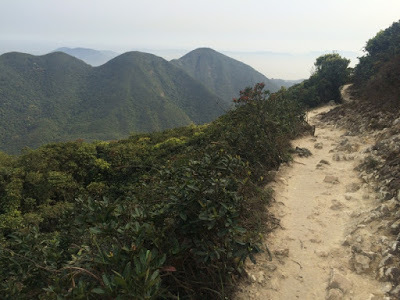
Infinity path:
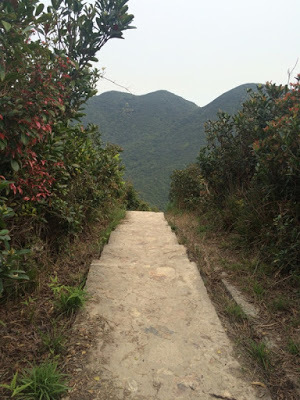
The area between peak 1 and 2:
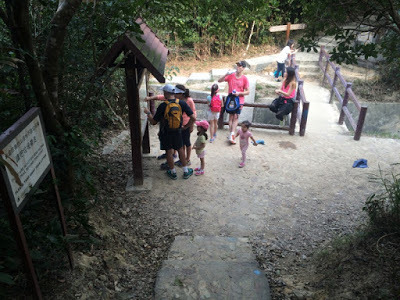
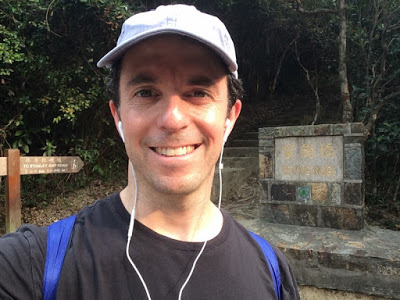
That's as far as you go, little one:
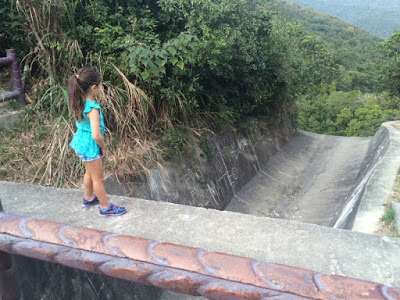
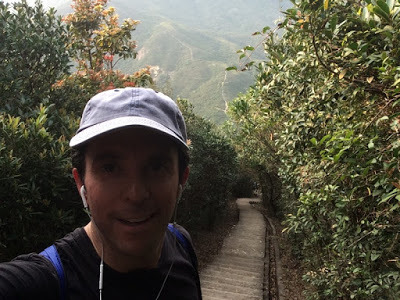
Twin Peak 1 is the toughest part of the hike. But I made it to the top:
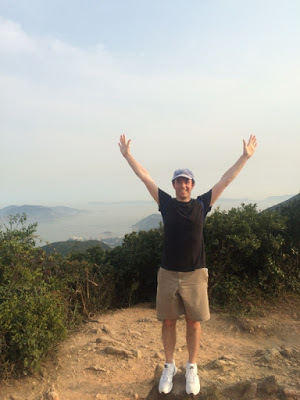
Ready to tackle peak 2 (in the background):
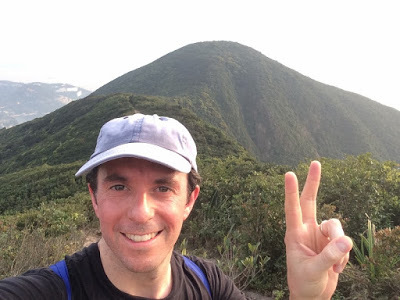
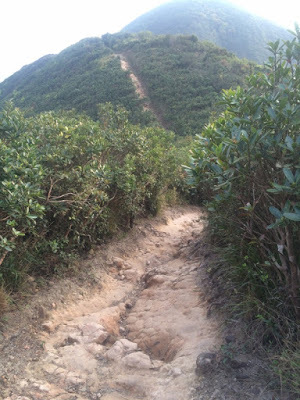
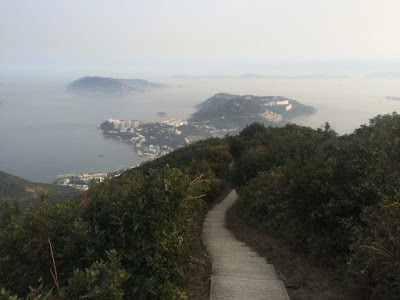
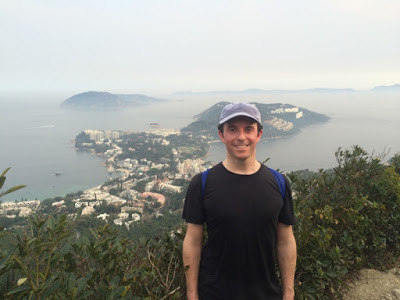
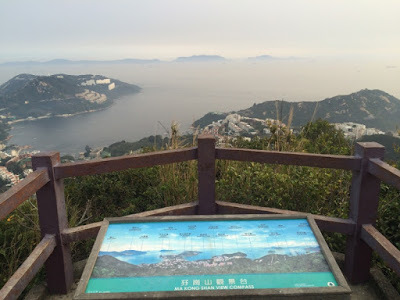
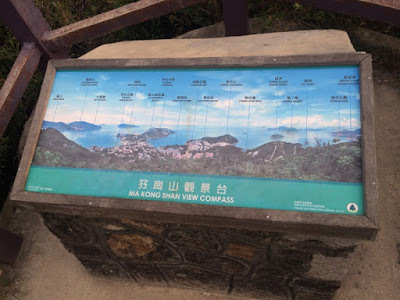
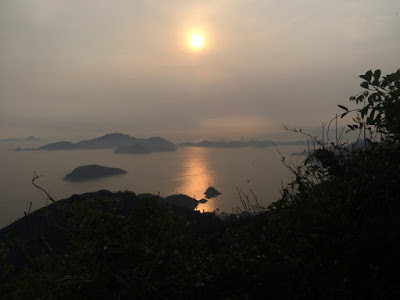
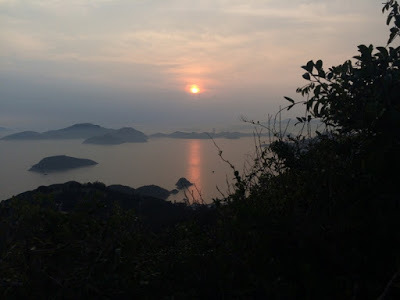
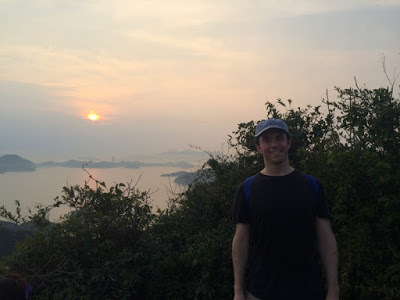
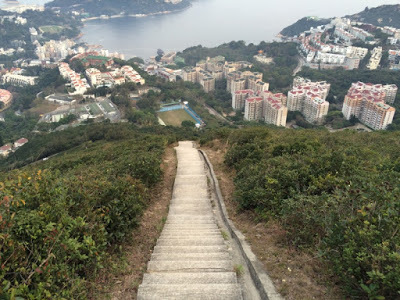
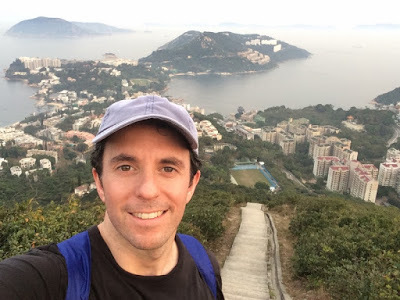
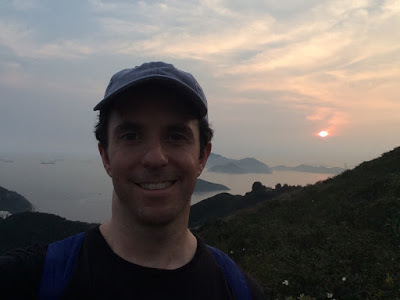
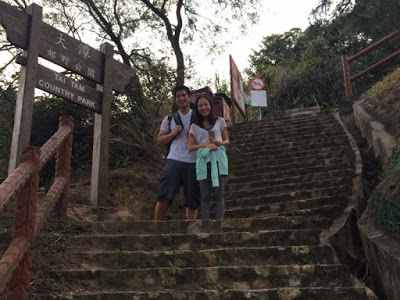
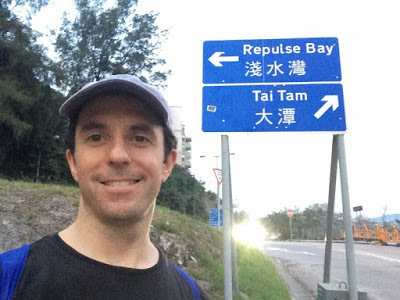
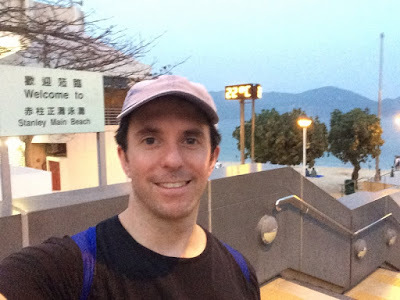
My ride back to the hotel; it may look like a mild-mannered double decker bus, but the (rather old) driver gunned that thing down the windy mountain road like he was fleeing killer bees.
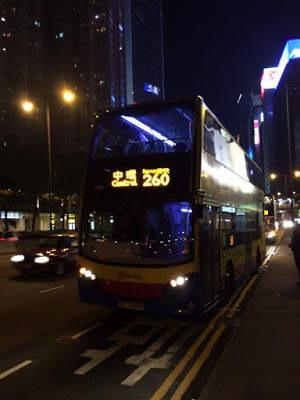
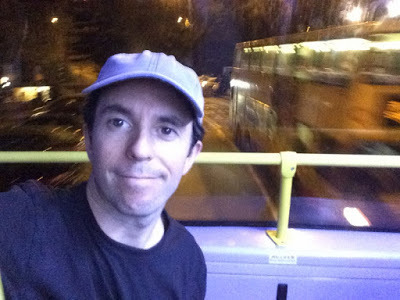
2/23/16 Kuala Lumpur to Phuket2/29/16 Phuket to Kuala Lumpur3/1/16 Kuala Lumpur to Phuket3/3/16 Phuket to Chiang Mai3/5/16 Chiang Mai to Hong Kong
A day after I walked with elephants in rural Thailand, I was in the middle of the high-rise city of Hong Kong, where I've come to speak at four international schools. I've learned that I prefer learning about a city once I'm in it; prior to being here, my knowledge of Hong Kong was barely even this:

Hong Kong: where airport staff made me take off my baseball hat five minutes before I reached immigration but did not care when I told them that someone left two plastic bags on the floor in line at immigration.
Within hours after arriving, after a nap to compensate for my 3:30 a.m. wake-up to make my 6 a.m. flight from Thailand, I was on the ferry from Hong Kong Island to Kowloon on the mainland.


Other sights from my wanderings:





Hong Kong junk:

Ball in the air:

The following day, I took on the Twin Peaks; at 3,000 steps (though they say 1,000), it's a workout with a view. And it's actually three peaks; the first is called Violet Hill. You start right behind here, a complex that looks cool but doesn't seem in close proximity to rolling hills:

The first part of the climb:





Remember that building I started at?



Pretty but precarious:


Infinity path:

The area between peak 1 and 2:


That's as far as you go, little one:


Twin Peak 1 is the toughest part of the hike. But I made it to the top:

Ready to tackle peak 2 (in the background):















My ride back to the hotel; it may look like a mild-mannered double decker bus, but the (rather old) driver gunned that thing down the windy mountain road like he was fleeing killer bees.


Published on March 08, 2016 04:00
March 6, 2016
Jurassic Park with elephants
Culminating my nine days in Thailand was a magical, mammoth experience: visiting an elephant sanctuary.
Elephants have been an integral part of Thai culture for centuries, but tragically, they are regularly mistreated in the name of commerce (tourist rides, street begging, circuses, logging). At Elephant Nature Park, rescued elephants are respected for the majestic creatures they are.

There is a glut of elephant-themed places to visit, and at first glance, it's hard to tell them apart. But this one came specially recommended in more ways than one, and it earned those endorsements. Even on the drive there we passed other elephant camps that did not look as humane—elephants penned in small enclosures right by the road.
You walk into ENP and it immediately seems like Jurassic Park with elephants. They roam free on the expansive and glorious grounds, gently and unobtrusively tended to by the staff of about 70. (But none of the elephants tried to eat us.)
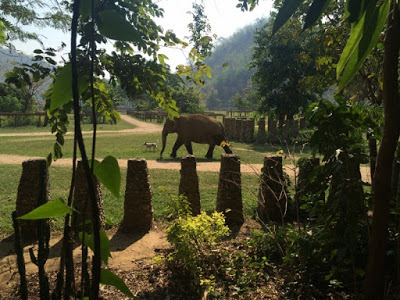
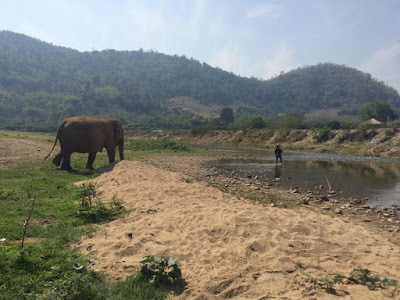
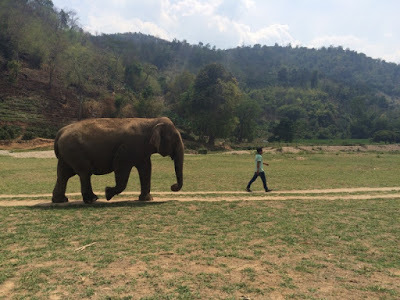
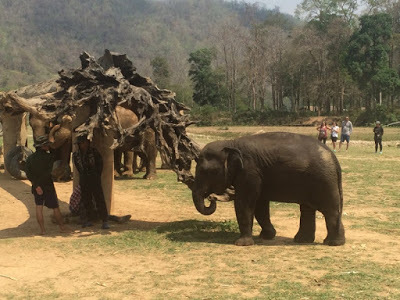
I chose the "short day" package, which ending up feeling full in the best way. My group departed the office in Chiang Mai at 9 a.m., was driven by van for about an hour to the sanctuary in the countryside, and enjoyed it (including a bountiful lunch) till the 2 p.m. departure. When I made my last-minute booking two nights before, the site said "only 11 slots left." Funnily, my group was only 12, suggesting I was actually the first to book. I was also the oldest in my group by more than 10 years. Mostly twenty-something backpackers, newlyweds, or European vacationers. The only other Americans were a brother and sister from Boston.
At ENP, the ones running things are the elephants. There is no riding, there are no shows, and there are no sticks in the hands of the mahouts, or men (has to be men) who train elephants. An elephant is assigned one mahout, often when the mahout is young, and the two stay together for the duration. In other places throughout Asia, mahouts use a sharp metal hook to control their elephants, and despite what the tourists are told, getting jabbed with it does hurt the animal. But at ENP, it's all positive reinforcement. Nothing sharp in sight.
Most elephants there are rescues. The humanitarian founder of the park buys them out of abusive situations. In one case, the cost was $2,000. In some of the elephants, heartbreaking tics linger; one swings his trunk and rocks when standing. It looks sweet till you learn the reason. To quote our sweet host/guide, Narissa (at least that's how it sounded), at ENP "elephants learn to become elephants again." She told us some of the elephants might cry when we receive them.
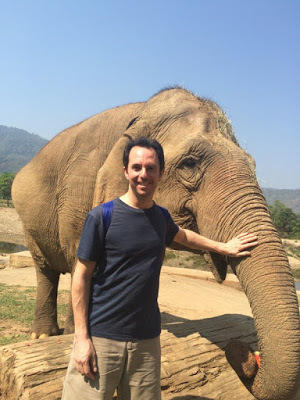
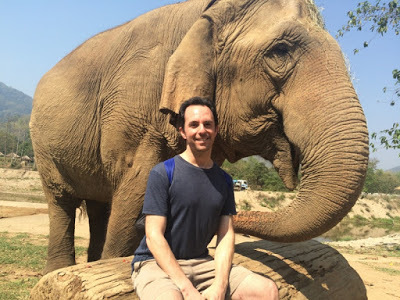
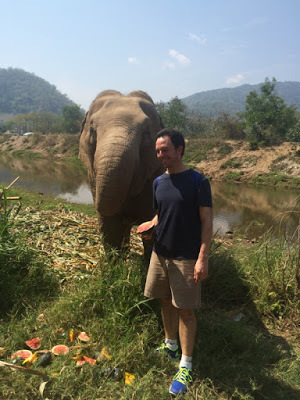
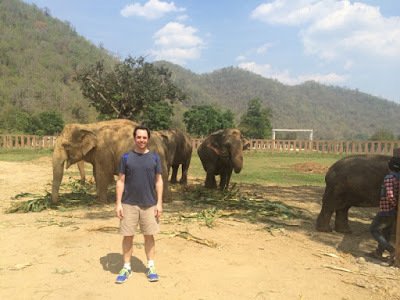
Almost a third of the 30 or so elephants there are blind by human means. People who come to ENP already have some spiritual or primal connection to these animals and hearing of these horrific examples of man's cruelty only intensifies that empathy. I found myself continuously thanking a higher power the whole time I was there that there was a there.
At least one elephant was older than my parents—born in the early 1940s. Narissa called some of them "grandma."
Most of the elephants in the park have formed small families—it seems like five or six animals apiece. One, however, has kept to herself in a particular spot—for nine years. While not social with her kind, she does let humans approach—some of the time. Here she is with Narissa, our guide.
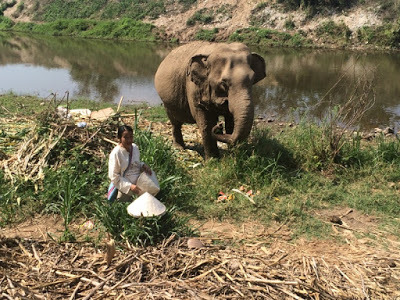
The mahouts live at the park in these structures:
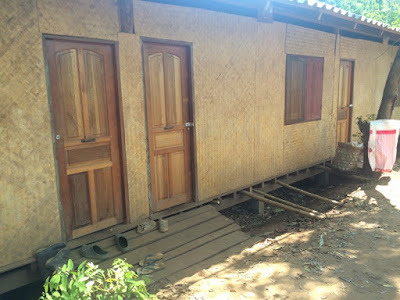
In the water, the adults surround the baby both to protect him and to play with him. He spent most of his river time rolling around underwater. See his trunk sticking out?
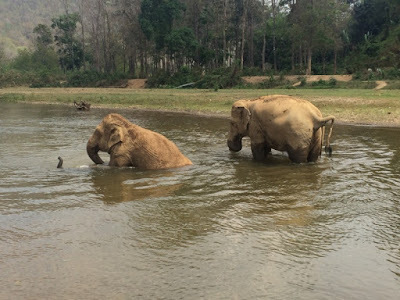
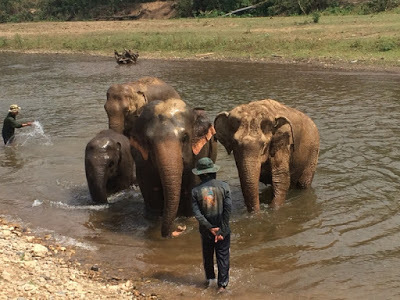
At ENP, humans follow the elephants' leads:
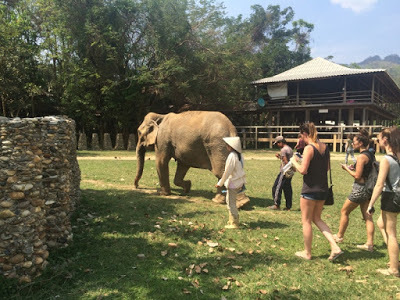
This is one of at least two elephants who stepped on a landmine near the Cambodian border, which you can see in his mangled front left foot. Narissa said they are lucky to be alive.
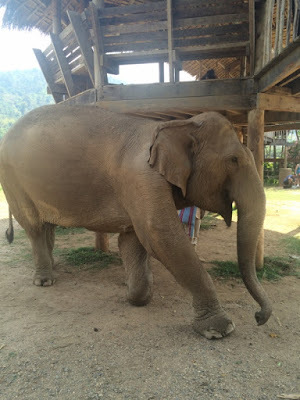
The only elephant who accessorized:
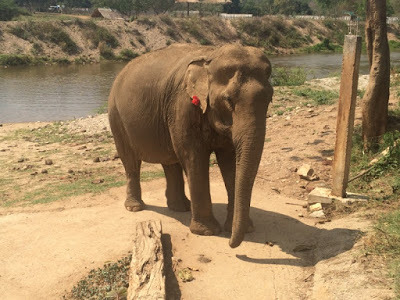
The day was so uplifting, emotionally draining, and hot that most of us fell asleep on the way home:
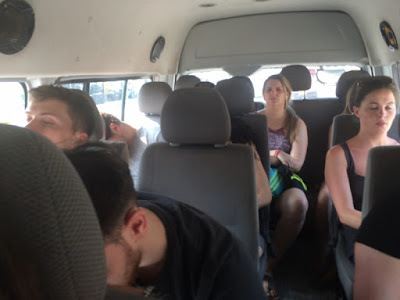
If you ever visit Thailand—or anywhere in Asia—get yourself to ENP. You might even consider planning a trip for this alone.
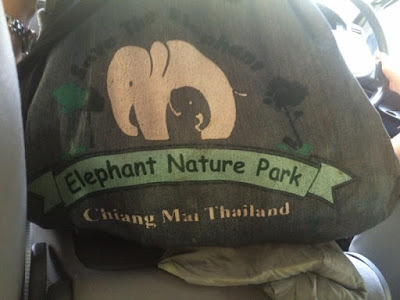
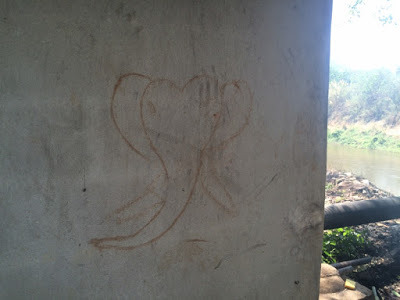
Thailand footnote: over my nine days, I ate pad see ew—my favorite dish (not just favorite Thai dish, but favorite of all dishes)—seven times:
2/25/16 lunch—local place my driver knew2/25/16 dinner—Boat Lagoon Resort (my first Phuket hotel)2/27/16 dinner—BLR 2/28/16 dinner—BLR 3/2/16 dinner—restaurant delivery to Bike Resort (my second Phuket hotel) 3/3/16 lunch—Golden Bell (my Chiang Mai hotel)3/4/16 dinner—Anoma Boutique House (a small hotel café in Chiang Mai old town)
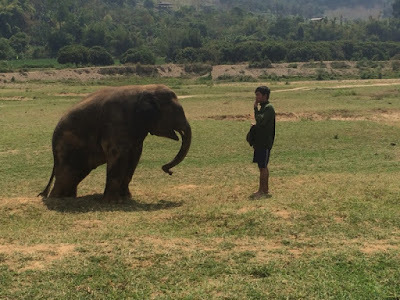
Elephants have been an integral part of Thai culture for centuries, but tragically, they are regularly mistreated in the name of commerce (tourist rides, street begging, circuses, logging). At Elephant Nature Park, rescued elephants are respected for the majestic creatures they are.

There is a glut of elephant-themed places to visit, and at first glance, it's hard to tell them apart. But this one came specially recommended in more ways than one, and it earned those endorsements. Even on the drive there we passed other elephant camps that did not look as humane—elephants penned in small enclosures right by the road.
You walk into ENP and it immediately seems like Jurassic Park with elephants. They roam free on the expansive and glorious grounds, gently and unobtrusively tended to by the staff of about 70. (But none of the elephants tried to eat us.)




I chose the "short day" package, which ending up feeling full in the best way. My group departed the office in Chiang Mai at 9 a.m., was driven by van for about an hour to the sanctuary in the countryside, and enjoyed it (including a bountiful lunch) till the 2 p.m. departure. When I made my last-minute booking two nights before, the site said "only 11 slots left." Funnily, my group was only 12, suggesting I was actually the first to book. I was also the oldest in my group by more than 10 years. Mostly twenty-something backpackers, newlyweds, or European vacationers. The only other Americans were a brother and sister from Boston.
At ENP, the ones running things are the elephants. There is no riding, there are no shows, and there are no sticks in the hands of the mahouts, or men (has to be men) who train elephants. An elephant is assigned one mahout, often when the mahout is young, and the two stay together for the duration. In other places throughout Asia, mahouts use a sharp metal hook to control their elephants, and despite what the tourists are told, getting jabbed with it does hurt the animal. But at ENP, it's all positive reinforcement. Nothing sharp in sight.
Most elephants there are rescues. The humanitarian founder of the park buys them out of abusive situations. In one case, the cost was $2,000. In some of the elephants, heartbreaking tics linger; one swings his trunk and rocks when standing. It looks sweet till you learn the reason. To quote our sweet host/guide, Narissa (at least that's how it sounded), at ENP "elephants learn to become elephants again." She told us some of the elephants might cry when we receive them.




Almost a third of the 30 or so elephants there are blind by human means. People who come to ENP already have some spiritual or primal connection to these animals and hearing of these horrific examples of man's cruelty only intensifies that empathy. I found myself continuously thanking a higher power the whole time I was there that there was a there.
At least one elephant was older than my parents—born in the early 1940s. Narissa called some of them "grandma."
Most of the elephants in the park have formed small families—it seems like five or six animals apiece. One, however, has kept to herself in a particular spot—for nine years. While not social with her kind, she does let humans approach—some of the time. Here she is with Narissa, our guide.

The mahouts live at the park in these structures:

In the water, the adults surround the baby both to protect him and to play with him. He spent most of his river time rolling around underwater. See his trunk sticking out?


At ENP, humans follow the elephants' leads:

This is one of at least two elephants who stepped on a landmine near the Cambodian border, which you can see in his mangled front left foot. Narissa said they are lucky to be alive.

The only elephant who accessorized:

The day was so uplifting, emotionally draining, and hot that most of us fell asleep on the way home:

If you ever visit Thailand—or anywhere in Asia—get yourself to ENP. You might even consider planning a trip for this alone.


Thailand footnote: over my nine days, I ate pad see ew—my favorite dish (not just favorite Thai dish, but favorite of all dishes)—seven times:
2/25/16 lunch—local place my driver knew2/25/16 dinner—Boat Lagoon Resort (my first Phuket hotel)2/27/16 dinner—BLR 2/28/16 dinner—BLR 3/2/16 dinner—restaurant delivery to Bike Resort (my second Phuket hotel) 3/3/16 lunch—Golden Bell (my Chiang Mai hotel)3/4/16 dinner—Anoma Boutique House (a small hotel café in Chiang Mai old town)

Published on March 06, 2016 04:00
March 4, 2016
Being spontaneous in Malaysia and Thailand
For more than a year, I planned what became monster trip to Asia—seven days at a school in Kuala Lumpur, Malaysia, two days at a school in Phuket, Thailand, and five days at four schools in Hong Kong. The way it shaped up, the bookings spread over four weeks with six weekdays that no schools requested.
While getting a week to tool around Asia would certainly be fantastic, it's not where I'm at in life. I'm already away from my family for too long; on top of that, to then spend rather than earn money for a week did not sit well with me.
The school visits started on February 15. By the next day, thanks to the kind word of mouth of educators who had just heard me present, I began to fill that gap week. Ultimately, I was able to schedule appearances for three of the five days—two schools and a company. Complicating that was the fact that one of the schools and the company were in Kuala Lumpur—but I was already in Thailand. Luckily, Asia has good budget airlines.
My gap week, revised:
Monday 2/29—rescheduled date for British International School of Phuket; that evening flew (back) to Kuala Lumpur (where I'd been from 2/13 to 2/23)Tuesday 3/1—British International School of Kuala Lumpur in the morning, Astro TV in the afternoon; that evening flew back to PhuketWednesday 3/2—Phuket International AcademyThursday 3/3—flew to Chiang Mai in the north, Thailand's second largest city, for two days before leaving for Hong Kong on 3/5; speaking of being spontaneous, I landed in Chiang Mai without knowing where I would sleep that night
Huge thanks again to Jeremy Townend at the British International School of Kuala Lumpur, Hakim Amir at Astro TV, and Lynne Nigalis at Phuket International Academy for inviting me on such short notice. Your spontaneity is a gift to your students (and to me). If this proves anything, it's that author visits can be relatively easy (and definitely quick) to put together!
British International School of Kuala Lumpur:
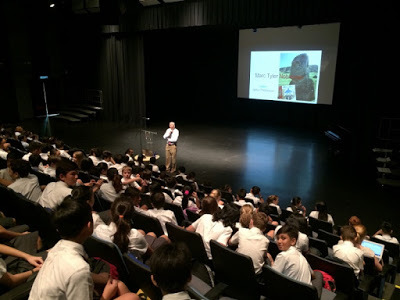
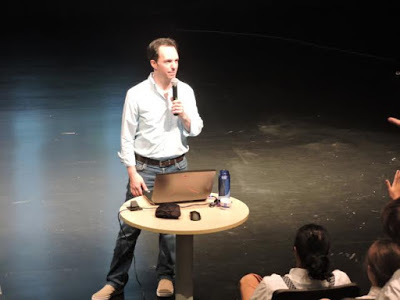 courtesy of Jeremy Townend
courtesy of Jeremy Townend
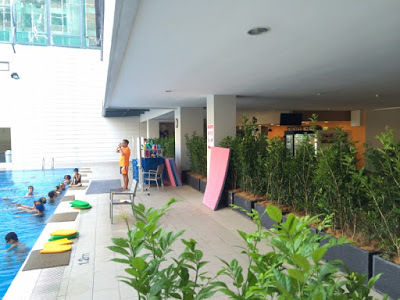

Astro TV, a large content provider:
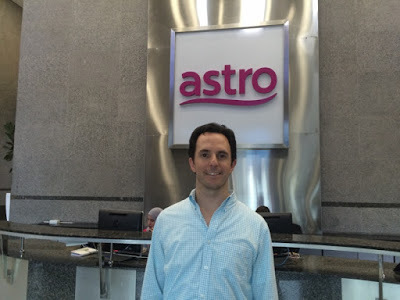
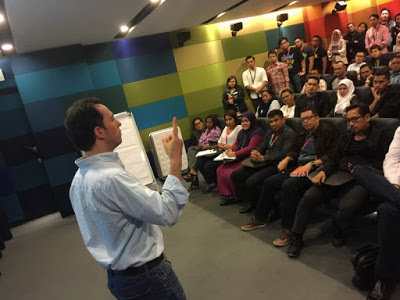 courtesy of Hakim Amir
courtesy of Hakim Amir
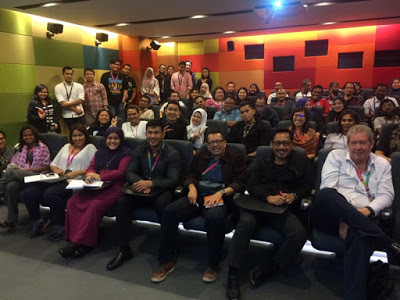
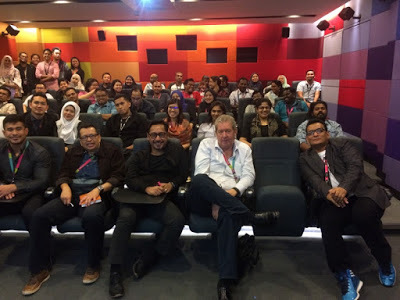
They asked me to do a selfie with the audience:
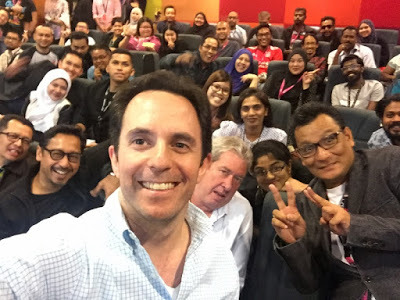
Phuket International Academy:
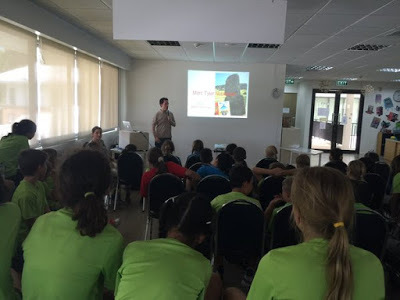 courtesy of PIA
courtesy of PIA
Day 1 of 2 in Chiang Mai; at the gate to the old city, which dates back to the 1200s:
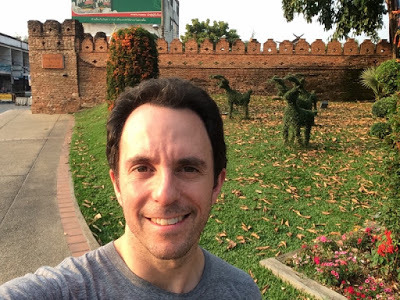
This place is not as exclusive as it might seem:
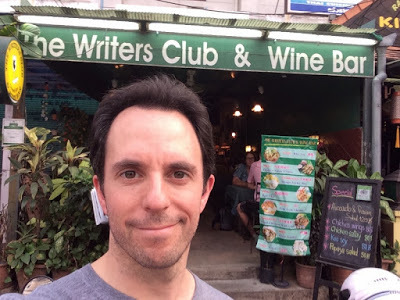
While getting a week to tool around Asia would certainly be fantastic, it's not where I'm at in life. I'm already away from my family for too long; on top of that, to then spend rather than earn money for a week did not sit well with me.
The school visits started on February 15. By the next day, thanks to the kind word of mouth of educators who had just heard me present, I began to fill that gap week. Ultimately, I was able to schedule appearances for three of the five days—two schools and a company. Complicating that was the fact that one of the schools and the company were in Kuala Lumpur—but I was already in Thailand. Luckily, Asia has good budget airlines.
My gap week, revised:
Monday 2/29—rescheduled date for British International School of Phuket; that evening flew (back) to Kuala Lumpur (where I'd been from 2/13 to 2/23)Tuesday 3/1—British International School of Kuala Lumpur in the morning, Astro TV in the afternoon; that evening flew back to PhuketWednesday 3/2—Phuket International AcademyThursday 3/3—flew to Chiang Mai in the north, Thailand's second largest city, for two days before leaving for Hong Kong on 3/5; speaking of being spontaneous, I landed in Chiang Mai without knowing where I would sleep that night
Huge thanks again to Jeremy Townend at the British International School of Kuala Lumpur, Hakim Amir at Astro TV, and Lynne Nigalis at Phuket International Academy for inviting me on such short notice. Your spontaneity is a gift to your students (and to me). If this proves anything, it's that author visits can be relatively easy (and definitely quick) to put together!
British International School of Kuala Lumpur:

 courtesy of Jeremy Townend
courtesy of Jeremy Townend

Astro TV, a large content provider:

 courtesy of Hakim Amir
courtesy of Hakim Amir

They asked me to do a selfie with the audience:

Phuket International Academy:
 courtesy of PIA
courtesy of PIADay 1 of 2 in Chiang Mai; at the gate to the old city, which dates back to the 1200s:

This place is not as exclusive as it might seem:

Published on March 04, 2016 04:00
March 2, 2016
Portraits of school staff…by kids
The site of the Phuket International Academy in Thailand does something clever: alongside the photographs of staff are portraits of said staff—drawn by kids.

I love when schools give kids opportunities to take part in ways that they don’t expect because that surely makes those kids feel special.

I love when schools give kids opportunities to take part in ways that they don’t expect because that surely makes those kids feel special.
Published on March 02, 2016 04:00
February 29, 2016
Bugs in Phuket, Thailand
On 2/23/16, I flew from Malaysia to Phuket, my first time in Thailand. Of the international destinations I’ve been fortunate to visit due to my work, this was one I was especially excited about. I love Thai food (one dish in particular, as you will soon see) and the beaches of Phuket are famously fetching.
My kind host from the British International School, Cindy Colson, picked me up and took me to dinner at a restaurant in the harbor complex of my hotel. My first meal in Thailand was, with no element of surprise, pad thai.
The harbor setting is lovely—lighthouses and the like—though I could have done without the boat engine throttling at 4:30 a.m. the next morning.
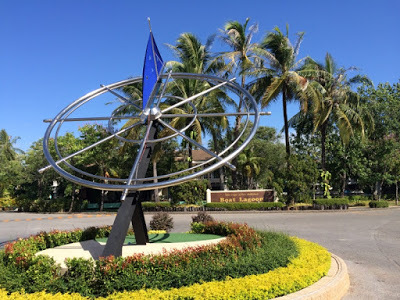
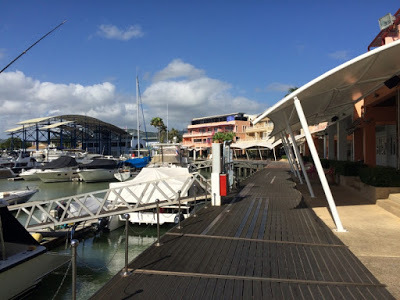
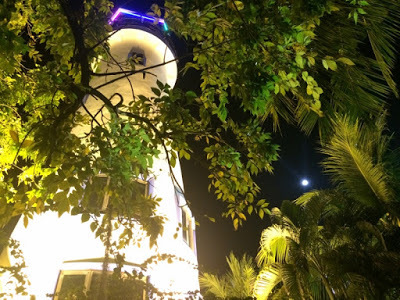
Before I arrived, I was told that (palm trees aside) BIS resembled another British school…albeit a fictional one.
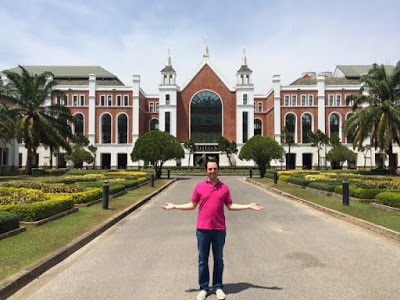
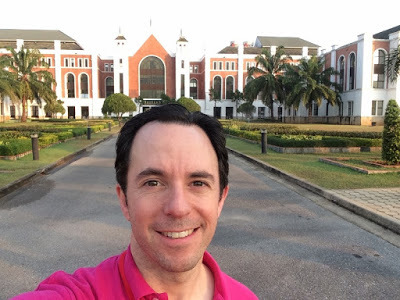
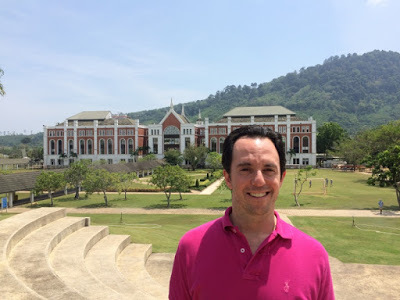
In her library, Cindy is a merchandising master. Here is her display for graphic novels:
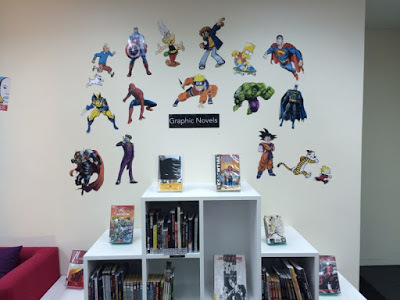
The bugs I am referring to in the title of this post are of two varieties. One is mosquitoes. I’ve never been snacked on more than I was on my second night in Thailand (at a lovely restaurant on the beach with school staff). Dozens of bites. My knees looked like the moon (if the moon had hair).
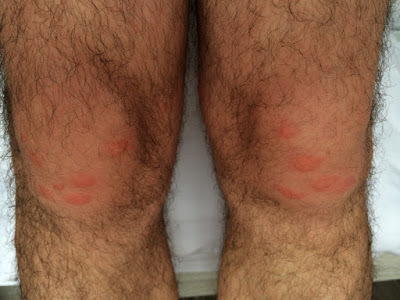
I learned that people with type O blood (like me) are often more appealing to mosquitoes, and I also learned I may have something called skeeter syndrome. It’s not as gross as it might sound. It simply describes people whose skin reacts more flamboyantly to mosquito bites. In my youth, the bites were dots, but now the bites are often big, bumpy, pink (and sometimes closer to red) splotches.
My nightly ritual was to hunt mosquitoes in my room.
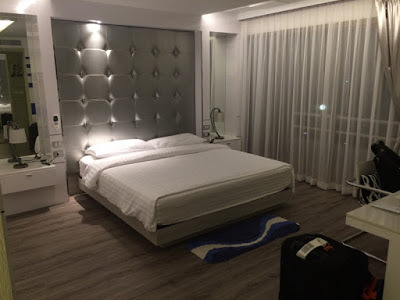
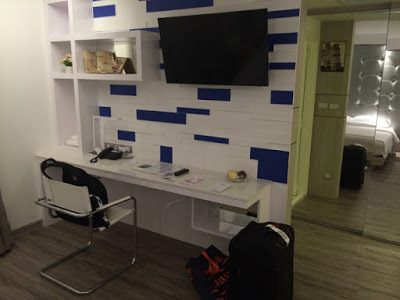
The other kind of bug is of the technical variety. The day before I arrived in Phuket, the provincial authorities announced that they would carry out checks on the power lines on the second of the two days I was scheduled to speak at the school (February 25). That would mean the school would have no electricity that day. That would mean no LCD projector…and, more pressingly in a steamy country like Thailand, no AC (or, as they say here, no air con). Tough in average situations and more so in rooms with many people.
Fortunately, I had already planned to be in Phuket beyond my two days at BIS so we agreed that we would reschedule me for the following day. However, not all groups that were slated to hear me on Thursday could fit me in on Friday, so we decided that I would do presentations for those groups on Monday.
The presentations went well. My favorite question, from a first grader: “What is the Riddler’s favorite country?”
I said that question was such a stumper that even the Riddler himself doesn’t know the answer.
On my Thursday off (during which time the staff and students had to sweat it out at the school), I explored the southwest coast of the island, where most of the beaches are. I started with Karon and made my way to Rawai (on the southern tip). One of them, Kata Noi, is #19 on Trip Advisor’s 2016 list of the 25 best beaches in the world.
Kata Noi beach, where I encountered a dark knight of a different kind:
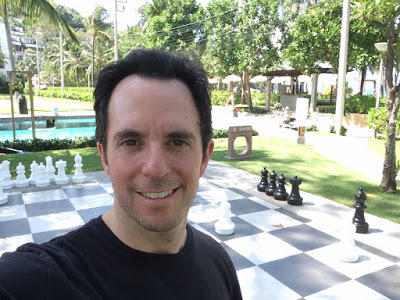
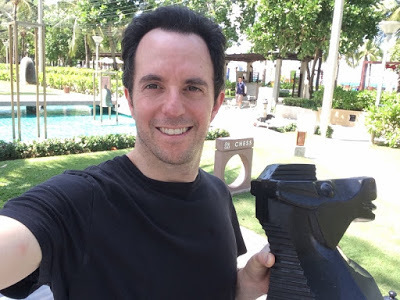
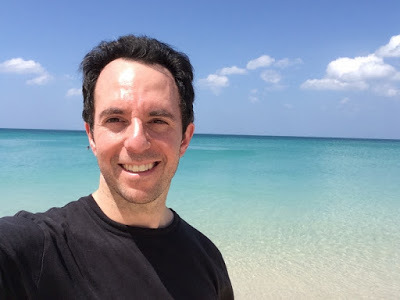
Nai Harn beach, where I saw the first of numerous couples taking wedding photos:
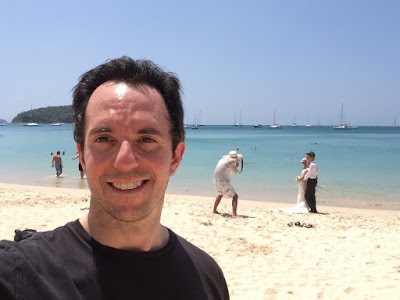
View over tiny Yanui Beach, perhaps my favorite of the ones I saw:
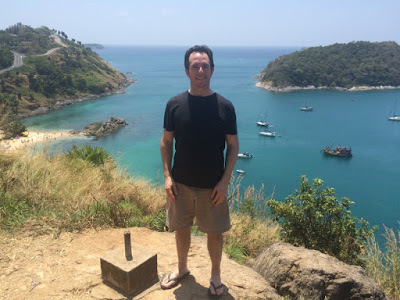
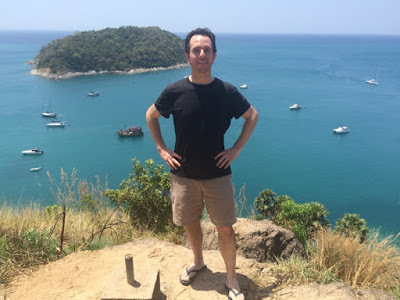
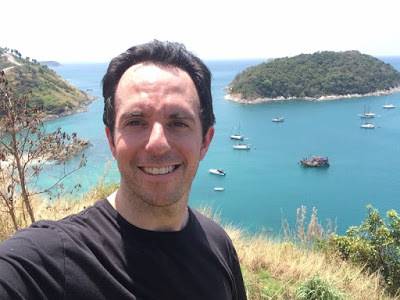
At Yanui there is a marker indicating that the 12/26/04 tsunami caused water to settle inland at 4 meters above sea level. (The date is hard to read but it’s below “4 m.”)
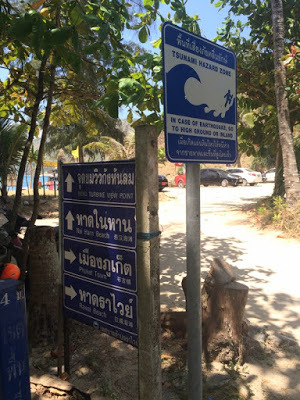
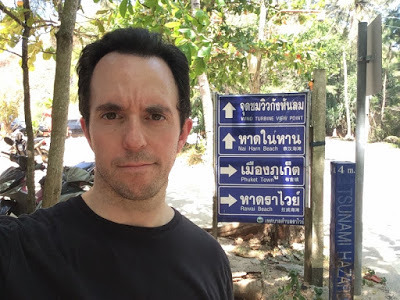
My driver Tor-ha sketched an explanation:
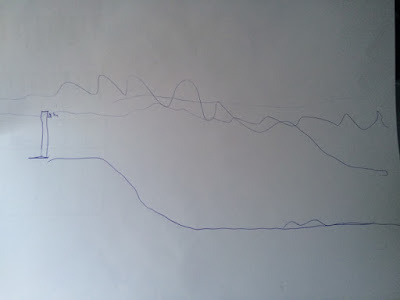
In other words, the marker itself is not 4 meters high but the top of it is 4 meters above sea level; you walk down a little slope to get to the beach near it.
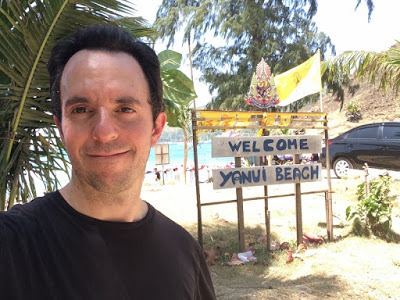

Phromptep Cape, one of the best views on the island, features an outcropping that is a symbol of Phuket:
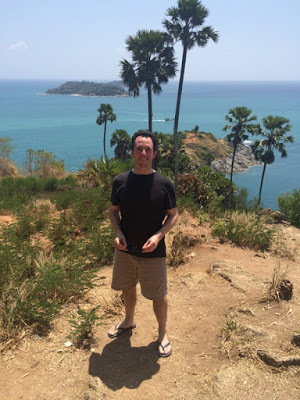
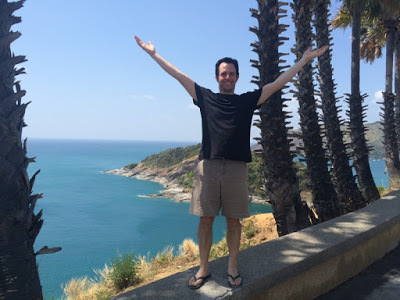
Another wedding photo shoot:
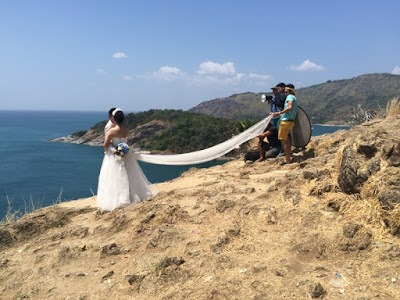
My first time eating pad see ew in Thailand; it is not only my favorite Thai dish but perhaps my favorite meal in general:
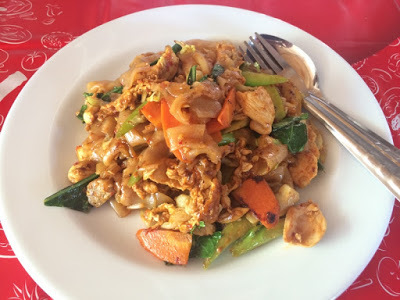
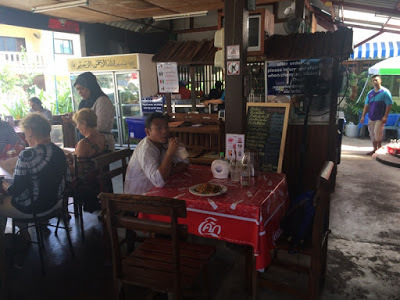
My self-directed tour ended with a stop at Big Buddha, the grounds of which are still being built but which is already open to the public:
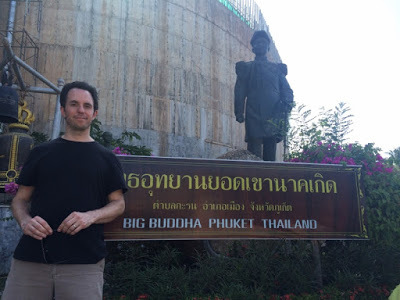
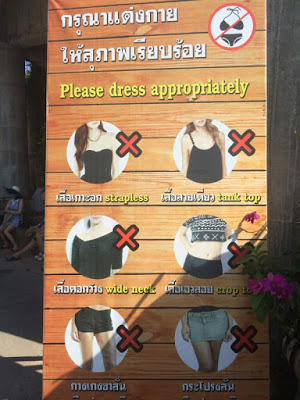
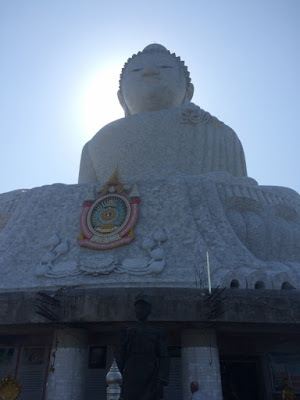
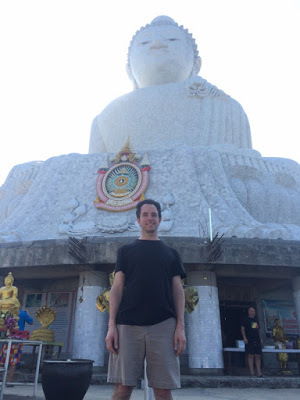
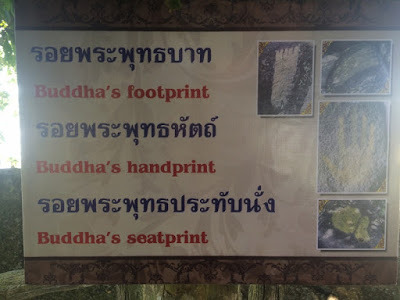
Construction began in 2004 and I’m told it has been funded almost completely via donations.
The cost of a driver (who also kindly volunteered to serve as tour guide and photographer) from 9 a.m. to 5 p.m. was $78. Tipping is not expected in Thailand, and when it does happen it is usually only change, but Tor-ha gave up his whole day for me, so I tipped him $12. He said “Too much” and I insisted. He gave up his whole day for me.
Plus his rear view mirror had a bat on it:
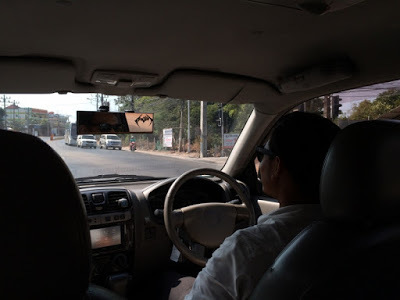
Other glimpses:
Elephants (and monkeys, and snakes) are indentured servants in Thailand, chained and at a tourist’s disposal for entertainment. I was conflicted to take this photo but was honored to get to touch such a majestic animal.
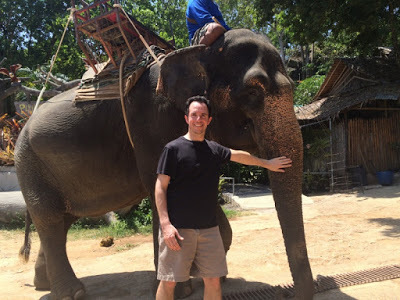
They look at you with such intelligence—and, some say, desperation—that it makes the system even more painful to observe. My driver said Americans in particular get upset at the way the elephants are ridden and kept, but he told me that the Thai people and elephants share a long, regal history. He said the elephants are assigned one trainer from birth so a relationship develops, and even a unique language between them. My driver also said that the elephants are treated humanely. That, of course, is not always true. But unless you are going to take action against the practice, believing it helps you bear it. Before I leave Thailand, I am hoping to visit an elephant sanctuary that gets raves for letting the animals roam freely—and letting them run the show. Tourists can pay to walk among them, but there is no riding and no confining.
Even tigers! This place is famous for letting tourists go into cages with tigers to pose for photos. They insist the animals are not drugged but again, that seems unlikely to be fully true. Even after a mauling in 2014, the place remains open.
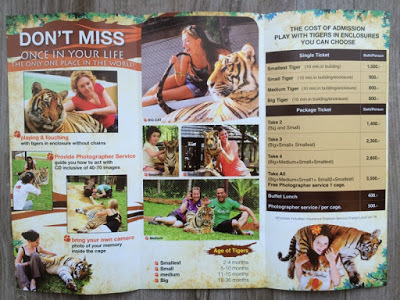
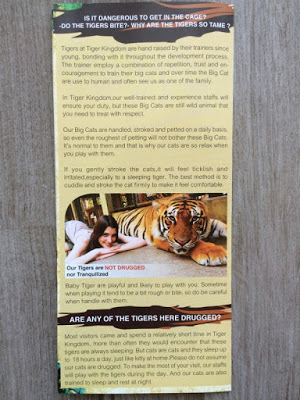
Sign in the bathroom in the lobby of my hotel:
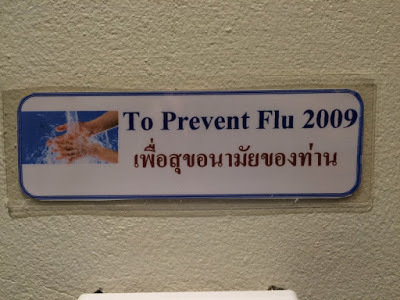
(No word on avoiding flus 2010-2016.)
Sign in the lobby of my hotel:
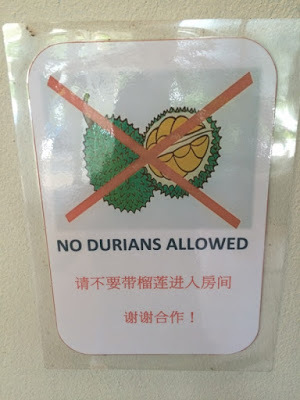
Durians are a regional fruit with a smell so pungent that hotels regularly forbid it.
The 1974 James Bond film The Man With the Golden Gun filmed scenes in Phuket and that beach is now a tourist destination. I was advised not to bother, and I heeded that advice.
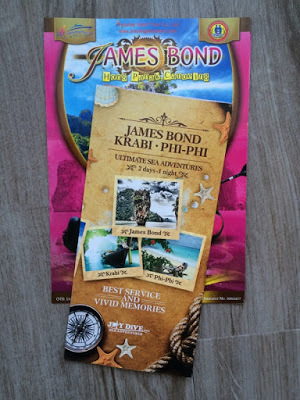
Thank you, Cindy and BIS, for making this experience possible.
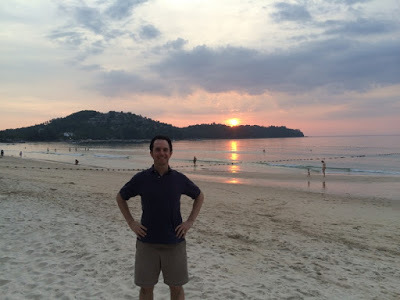
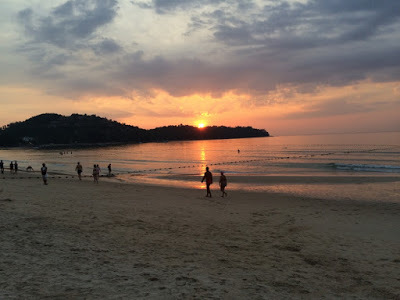
My kind host from the British International School, Cindy Colson, picked me up and took me to dinner at a restaurant in the harbor complex of my hotel. My first meal in Thailand was, with no element of surprise, pad thai.
The harbor setting is lovely—lighthouses and the like—though I could have done without the boat engine throttling at 4:30 a.m. the next morning.



Before I arrived, I was told that (palm trees aside) BIS resembled another British school…albeit a fictional one.



In her library, Cindy is a merchandising master. Here is her display for graphic novels:

The bugs I am referring to in the title of this post are of two varieties. One is mosquitoes. I’ve never been snacked on more than I was on my second night in Thailand (at a lovely restaurant on the beach with school staff). Dozens of bites. My knees looked like the moon (if the moon had hair).

I learned that people with type O blood (like me) are often more appealing to mosquitoes, and I also learned I may have something called skeeter syndrome. It’s not as gross as it might sound. It simply describes people whose skin reacts more flamboyantly to mosquito bites. In my youth, the bites were dots, but now the bites are often big, bumpy, pink (and sometimes closer to red) splotches.
My nightly ritual was to hunt mosquitoes in my room.


The other kind of bug is of the technical variety. The day before I arrived in Phuket, the provincial authorities announced that they would carry out checks on the power lines on the second of the two days I was scheduled to speak at the school (February 25). That would mean the school would have no electricity that day. That would mean no LCD projector…and, more pressingly in a steamy country like Thailand, no AC (or, as they say here, no air con). Tough in average situations and more so in rooms with many people.
Fortunately, I had already planned to be in Phuket beyond my two days at BIS so we agreed that we would reschedule me for the following day. However, not all groups that were slated to hear me on Thursday could fit me in on Friday, so we decided that I would do presentations for those groups on Monday.
The presentations went well. My favorite question, from a first grader: “What is the Riddler’s favorite country?”
I said that question was such a stumper that even the Riddler himself doesn’t know the answer.
On my Thursday off (during which time the staff and students had to sweat it out at the school), I explored the southwest coast of the island, where most of the beaches are. I started with Karon and made my way to Rawai (on the southern tip). One of them, Kata Noi, is #19 on Trip Advisor’s 2016 list of the 25 best beaches in the world.
Kata Noi beach, where I encountered a dark knight of a different kind:



Nai Harn beach, where I saw the first of numerous couples taking wedding photos:

View over tiny Yanui Beach, perhaps my favorite of the ones I saw:



At Yanui there is a marker indicating that the 12/26/04 tsunami caused water to settle inland at 4 meters above sea level. (The date is hard to read but it’s below “4 m.”)


My driver Tor-ha sketched an explanation:

In other words, the marker itself is not 4 meters high but the top of it is 4 meters above sea level; you walk down a little slope to get to the beach near it.


Phromptep Cape, one of the best views on the island, features an outcropping that is a symbol of Phuket:


Another wedding photo shoot:

My first time eating pad see ew in Thailand; it is not only my favorite Thai dish but perhaps my favorite meal in general:


My self-directed tour ended with a stop at Big Buddha, the grounds of which are still being built but which is already open to the public:





Construction began in 2004 and I’m told it has been funded almost completely via donations.
The cost of a driver (who also kindly volunteered to serve as tour guide and photographer) from 9 a.m. to 5 p.m. was $78. Tipping is not expected in Thailand, and when it does happen it is usually only change, but Tor-ha gave up his whole day for me, so I tipped him $12. He said “Too much” and I insisted. He gave up his whole day for me.
Plus his rear view mirror had a bat on it:

Other glimpses:
Elephants (and monkeys, and snakes) are indentured servants in Thailand, chained and at a tourist’s disposal for entertainment. I was conflicted to take this photo but was honored to get to touch such a majestic animal.

They look at you with such intelligence—and, some say, desperation—that it makes the system even more painful to observe. My driver said Americans in particular get upset at the way the elephants are ridden and kept, but he told me that the Thai people and elephants share a long, regal history. He said the elephants are assigned one trainer from birth so a relationship develops, and even a unique language between them. My driver also said that the elephants are treated humanely. That, of course, is not always true. But unless you are going to take action against the practice, believing it helps you bear it. Before I leave Thailand, I am hoping to visit an elephant sanctuary that gets raves for letting the animals roam freely—and letting them run the show. Tourists can pay to walk among them, but there is no riding and no confining.
Even tigers! This place is famous for letting tourists go into cages with tigers to pose for photos. They insist the animals are not drugged but again, that seems unlikely to be fully true. Even after a mauling in 2014, the place remains open.


Sign in the bathroom in the lobby of my hotel:

(No word on avoiding flus 2010-2016.)
Sign in the lobby of my hotel:

Durians are a regional fruit with a smell so pungent that hotels regularly forbid it.
The 1974 James Bond film The Man With the Golden Gun filmed scenes in Phuket and that beach is now a tourist destination. I was advised not to bother, and I heeded that advice.

Thank you, Cindy and BIS, for making this experience possible.


Published on February 29, 2016 04:00
February 21, 2016
High points of Kuala Lumpur
On the weekend between my visits to the International School of Kuala Lumpur (first middle/upper, then lower school), I got high in two ways.
First by elevator—34 floors.
Then by foot—1,312 feet.
On 2/20/16, I went to the Heli Lounge Bar, a pleasant 10-minute walk from my hotel. By night, it’s (you guessed it) a bar—with minimal protective railing. By day, it’s (you might’ve guessed it) a helipad—with no more protective railing than at night.
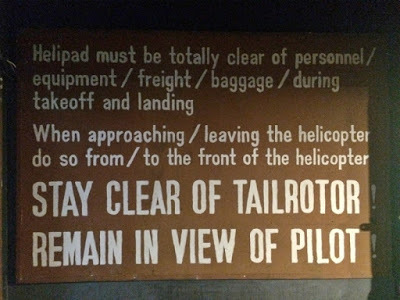
As guests marvel at the 360-degree view of the city, they sit in simple plastic chairs right on the spot where choppers land.
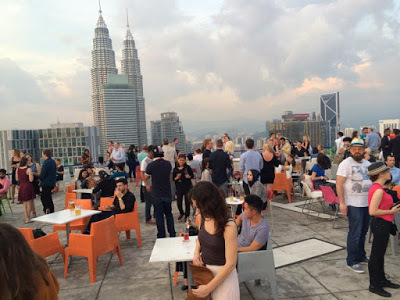
This demands to be in panorama:


Some people recommend getting your altitude fix here rather than up in the more famous Petronas Towers or KL Tower because from this bar, you get a wild view of both of those landmarks.
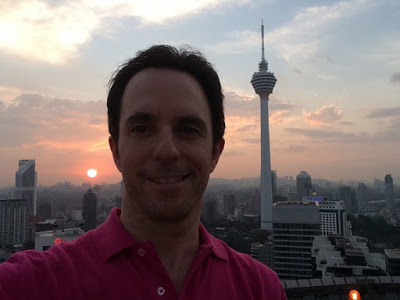
Petronas as the evening wore on:
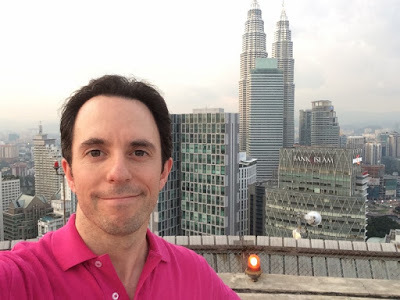

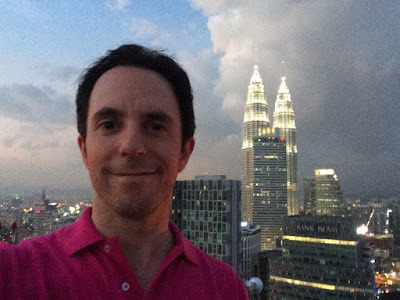
Sorry for the selfie onslaught. I am man alone here.
Spot the moon:
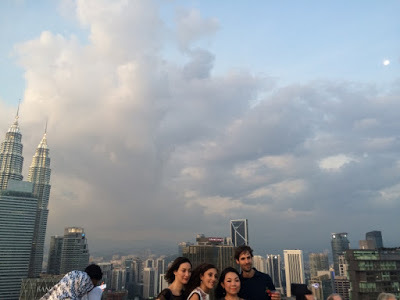
These images were taken between 6:45 p.m. and sunset at 7:30 p.m. (times approximate).
On the way out, I tried to capture the height of the roof—apparently, until sometime relatively recently, you could walk right to the edge.
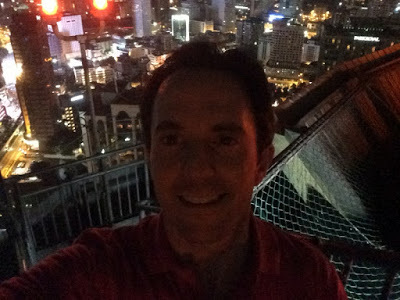
Now they have a barricade—stanchions, like you see at the bank.
The following morning I woke at 4:45 a.m. to see the sunrise at Broga Hill, a 40-minute drive from the city.
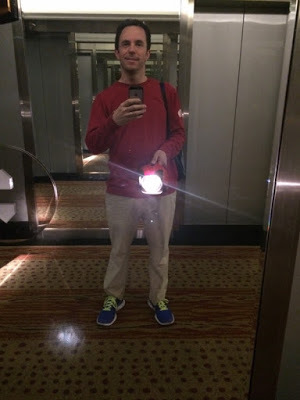
Why so early if it is not that far? Because first you have to hike up to the top. Why so long if it’s not that high? Because a) it gets so steep at times that you need to pull yourself up by installed ropes (kind of like stronger, more vertical stanchions) and b) it is crowded. Trip Advisor warned of this but it’s quite another thing to see it in person. It was a steady stream of people the whole way up, and some parts were single file, meaning your pace is at the mercy of the person in front of you. You pass two lower viewing stations but I wanted to go as high as possible, both for the better view and for more legroom. However, at the top, which I reached when it was still pitch-black, I was quite limited in my choices of where to stand to wait for the sun.
There were two dominant characteristics of the climbers: young and Asian. I was one of the oldest people I saw—and one of only three Caucasians. Most women wore a hijab (Islamic headdress that seems the most modest of styles).
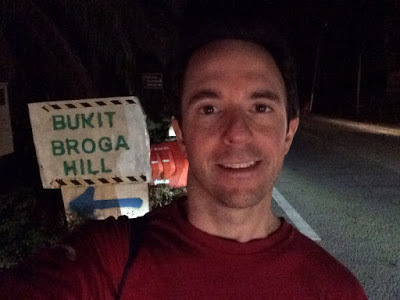
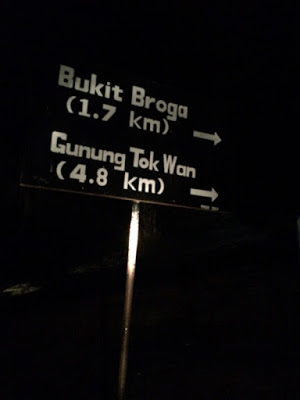
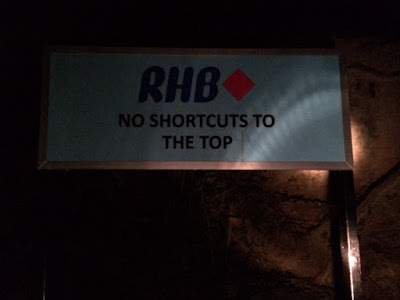
Lights of hikers ahead of me eerily rising up in the distance:
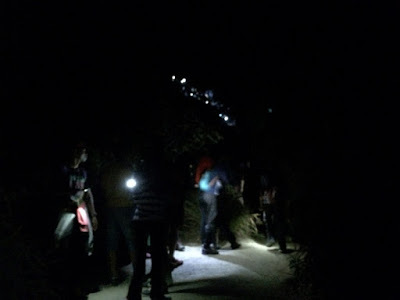
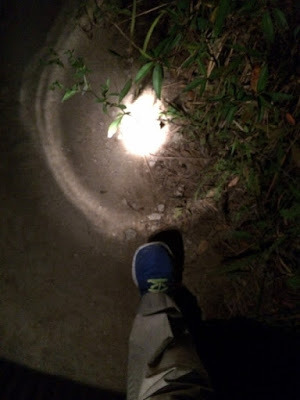
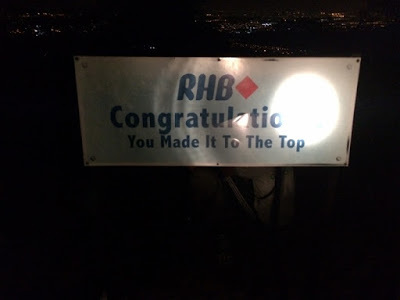
Awkward to take a selfie when you must also provide your light source:
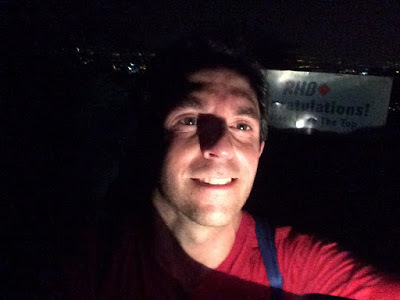
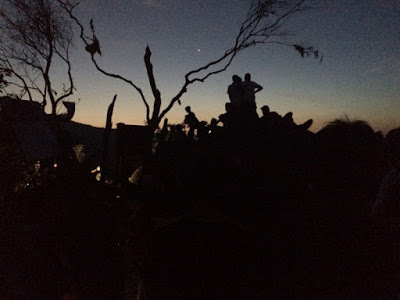
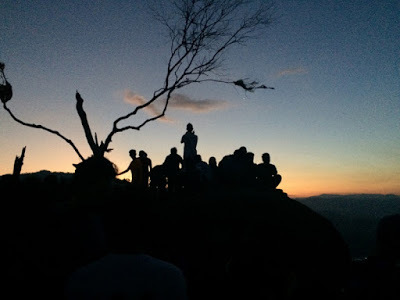
The “you made it to the top” sign again, in slightly more light:
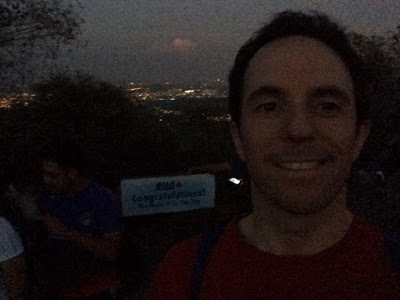
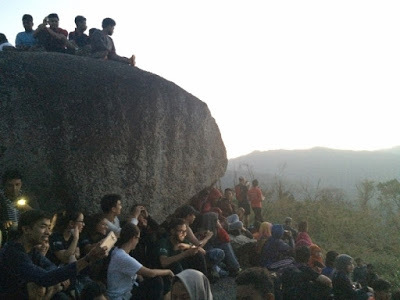
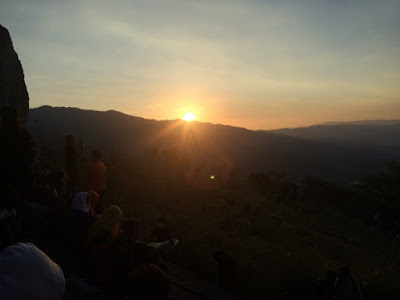
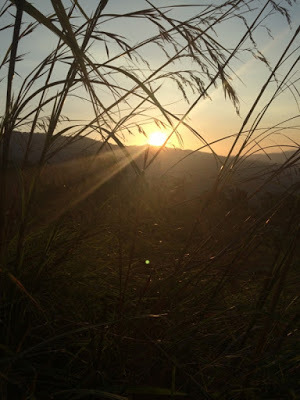
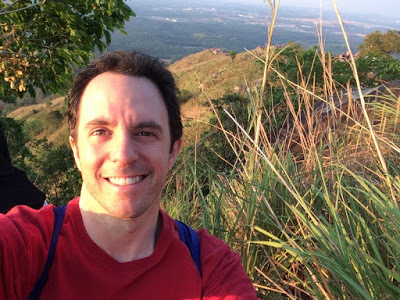
Looks almost like Scottish highlands, though I have not been there:
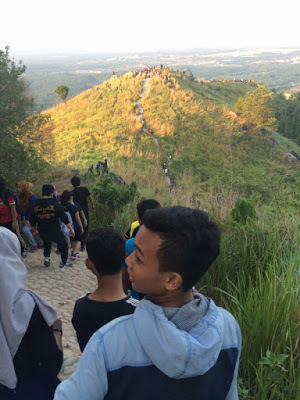
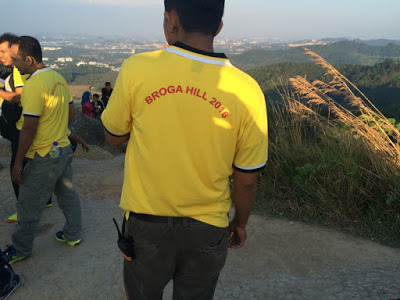
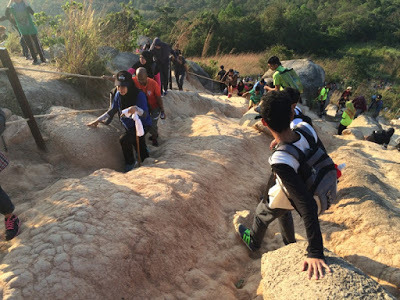
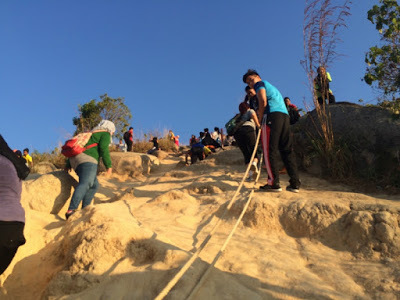
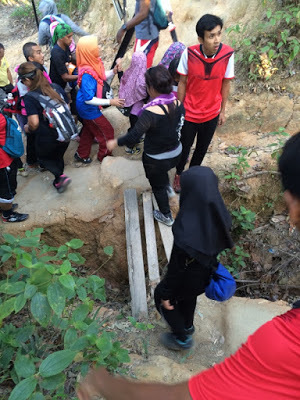
What I brought up Broga Hill in my new ultra-light travel day pack ($30):
(Bolded items went unused.)
water—three bottles (drank less than one)dried applesmosquito spraysunscreenhuge flashlight borrowed from hotelmicro-fiber towelwipestowel paperpad and penhatextra T-shirtearbudssalt (in case of leeches)business card of conciergecash (to pay the cab driver, who waited for me for three hours)
When I say “ultra-light,” I mean this: it packs up to a nugget a little smaller than a computer mouse.
A portion of my gear:
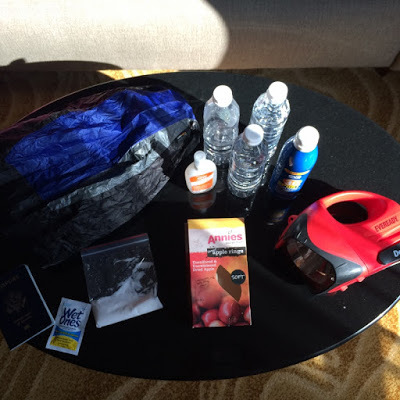
Began hiking about 5:50. Reached top 6:30. Began descent about 7:45. Back at cab 8:30.
Here are three sights on the way up compared to on the back down, starting with a simple food stand near the base:
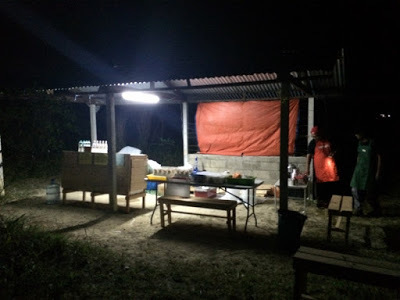
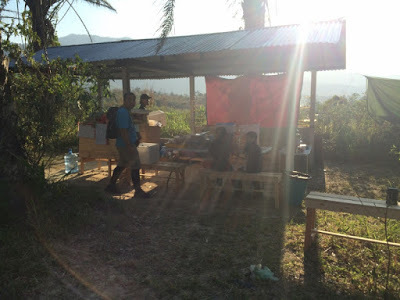
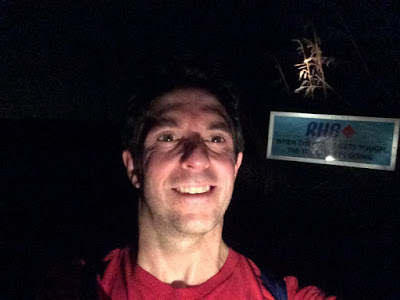
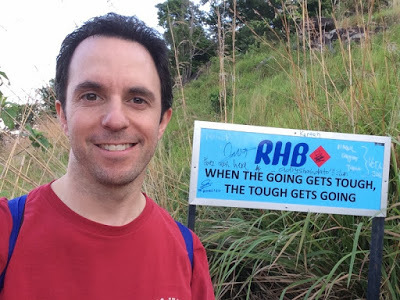
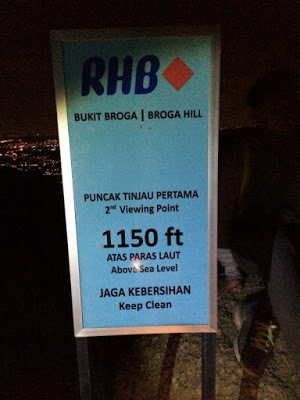
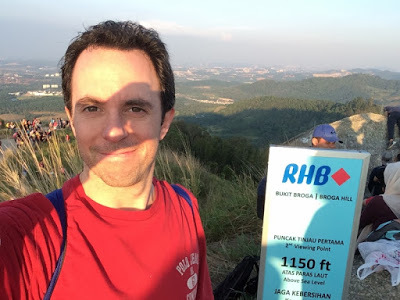
Once in daylight, the scope of the foot traffic was amplified by the parking lot—it was a few cars short of a Taylor Swift concert crowd.
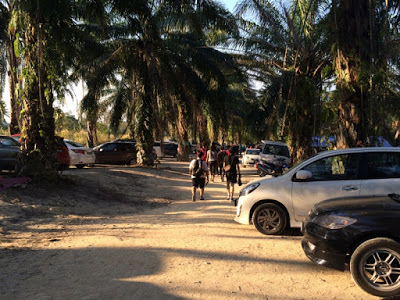
It was a shot like the following that drew me to Broga Hill. The real thing delivered.
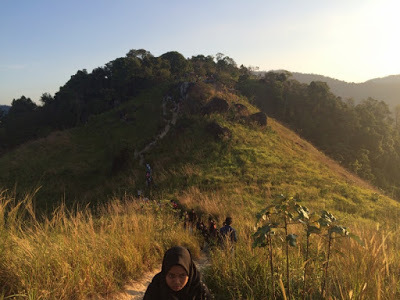
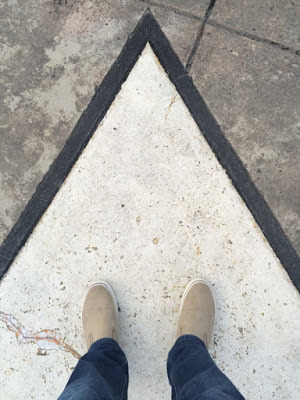 Going up.
Going up.
First by elevator—34 floors.
Then by foot—1,312 feet.
On 2/20/16, I went to the Heli Lounge Bar, a pleasant 10-minute walk from my hotel. By night, it’s (you guessed it) a bar—with minimal protective railing. By day, it’s (you might’ve guessed it) a helipad—with no more protective railing than at night.

As guests marvel at the 360-degree view of the city, they sit in simple plastic chairs right on the spot where choppers land.

This demands to be in panorama:


Some people recommend getting your altitude fix here rather than up in the more famous Petronas Towers or KL Tower because from this bar, you get a wild view of both of those landmarks.

Petronas as the evening wore on:



Sorry for the selfie onslaught. I am man alone here.
Spot the moon:

These images were taken between 6:45 p.m. and sunset at 7:30 p.m. (times approximate).
On the way out, I tried to capture the height of the roof—apparently, until sometime relatively recently, you could walk right to the edge.

Now they have a barricade—stanchions, like you see at the bank.
The following morning I woke at 4:45 a.m. to see the sunrise at Broga Hill, a 40-minute drive from the city.

Why so early if it is not that far? Because first you have to hike up to the top. Why so long if it’s not that high? Because a) it gets so steep at times that you need to pull yourself up by installed ropes (kind of like stronger, more vertical stanchions) and b) it is crowded. Trip Advisor warned of this but it’s quite another thing to see it in person. It was a steady stream of people the whole way up, and some parts were single file, meaning your pace is at the mercy of the person in front of you. You pass two lower viewing stations but I wanted to go as high as possible, both for the better view and for more legroom. However, at the top, which I reached when it was still pitch-black, I was quite limited in my choices of where to stand to wait for the sun.
There were two dominant characteristics of the climbers: young and Asian. I was one of the oldest people I saw—and one of only three Caucasians. Most women wore a hijab (Islamic headdress that seems the most modest of styles).



Lights of hikers ahead of me eerily rising up in the distance:



Awkward to take a selfie when you must also provide your light source:



The “you made it to the top” sign again, in slightly more light:





Looks almost like Scottish highlands, though I have not been there:





What I brought up Broga Hill in my new ultra-light travel day pack ($30):
(Bolded items went unused.)
water—three bottles (drank less than one)dried applesmosquito spraysunscreenhuge flashlight borrowed from hotelmicro-fiber towelwipestowel paperpad and penhatextra T-shirtearbudssalt (in case of leeches)business card of conciergecash (to pay the cab driver, who waited for me for three hours)
When I say “ultra-light,” I mean this: it packs up to a nugget a little smaller than a computer mouse.
A portion of my gear:

Began hiking about 5:50. Reached top 6:30. Began descent about 7:45. Back at cab 8:30.
Here are three sights on the way up compared to on the back down, starting with a simple food stand near the base:






Once in daylight, the scope of the foot traffic was amplified by the parking lot—it was a few cars short of a Taylor Swift concert crowd.

It was a shot like the following that drew me to Broga Hill. The real thing delivered.

 Going up.
Going up.
Published on February 21, 2016 04:00
February 20, 2016
Keep calm and Kuala Lumpur
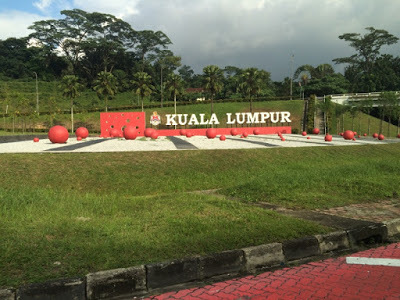
My five-day experience at the middle/upper campus of International School of Kuala Lumpur was stellar. After one of my talks, a girl told me she’d heard me present (about two years ago)…at her Virginia middle school. First time I’m aware of that I’ve encountered a student twice—but on different continents.
One night, my kind host Beau Cain and his equally kind wife took me to dinner in Kuala Lumpur. Another first for me: ordering Thai food at an Irish pub (in Malaysia, no less).
The day I arrived, I’d heard from Malaysian radio personality Umapagan (Uma) Ampikaipakan, who does a popular drive-time show and also produces When We Last Left Our Heroes, a monthly radio show/podcast about the cultural influence of superheroes. He asked if I’d come on the show.
It was fun to discover that I have had professional dealings with several of the gents (Paul Levitz, Neal Adams, Brian Cronin, Arnold Blumberg) who have been on Uma’s show. Yet another first: I was the first guest on the show to be interviewed at the studio.
To get me back to my hotel, Uma ordered an Uber. When I got in the car (while Uma was upstairs on the air), the driver said “You’re not Uma.” Uma is a local celeb and I totally dashed the driver’s hopes. When I asked Vernon (his real name) how long it would take to walk to my hotel from the mall he was taking me to, he said he wasn’t sure. He elaborated: “In KL, only white people walk.”
At that mall, I visited the DC Superheroes store. Unlike most mall stores, it has two entrances:
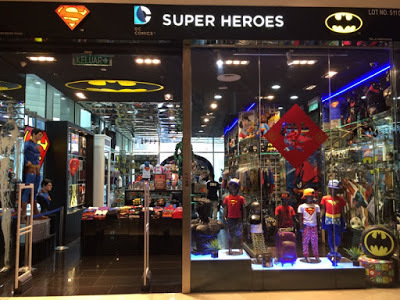
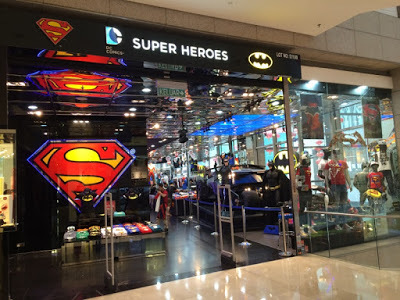
Interestingly (though not in a good way), the store sells no comics and very little reading material.
Published on February 20, 2016 04:00
February 19, 2016
Best of the blog 2015
This blog launched on 2/19/08.
Every February 19, I share what I feel have been the previous twelve months’ posts with the most.
This year’s elite:
transcends category
Bill Finger will now be officially credited on Batman
fans, celebrities, and media respond to Bill Finger credit announcement
Bill Finger credit begins to appear on TV shows and in comics
making the case that Bill Finger deserves co-creator status
top 10 pop culture moments of 2015
interviews
Robert vanMaanen, who as a boy in the early 1970s befriended his neighbor, Bill Finger
Lee Ann Marie, the girl in the video for the 1984 Survivor song “I Can’t Hold Back”…and the unofficial 2015 sequel video
Howard Murphy, who played the first live-action Green Lantern (in the two-part 1979 TV special Legends of the Superheroes)
speaking
feedback: Tennessee Association of School Librarians conference 2015
feedback: Charlotte S. Huck Children's Literature Festival 2015
feedback: University of Pittsburgh at Greensburg Children’s Literature Conference 2015
how I got to the American Association of School Librarians 2015 conference
mentioning a person is gay in rural Tennessee schools
research
what Bill Finger left behind
publishing
Proust Questionnaire: Kidlit Edition
your life is nonfiction
my book dedications
my picture book pantheon
miscellaneous
Co-Creator, the (first) play about Bill Finger
visiting the Taj Mahal (don’t miss the time-lapse video) and the site where Gandhi was assassinated
Bill Finger action figure
wordplay with “Bill,” “Finger,” and “bat” in Bill the Boy Wonder
a mural tribute to the 1970s Sea World water skiing superheroes show
my college paper on The New Yorker magazine
me at famous historical sites
the Phi Beta Kappa cartoon controversy
rejections for my cartoons
two published insults to Bill Finger, one early and one posthumous
superheroes who are not called superheroes
I was a teenage photographer
Every February 19, I share what I feel have been the previous twelve months’ posts with the most.
This year’s elite:
transcends category
Bill Finger will now be officially credited on Batman
fans, celebrities, and media respond to Bill Finger credit announcement
Bill Finger credit begins to appear on TV shows and in comics
making the case that Bill Finger deserves co-creator status
top 10 pop culture moments of 2015
interviews
Robert vanMaanen, who as a boy in the early 1970s befriended his neighbor, Bill Finger
Lee Ann Marie, the girl in the video for the 1984 Survivor song “I Can’t Hold Back”…and the unofficial 2015 sequel video
Howard Murphy, who played the first live-action Green Lantern (in the two-part 1979 TV special Legends of the Superheroes)
speaking
feedback: Tennessee Association of School Librarians conference 2015
feedback: Charlotte S. Huck Children's Literature Festival 2015
feedback: University of Pittsburgh at Greensburg Children’s Literature Conference 2015
how I got to the American Association of School Librarians 2015 conference
mentioning a person is gay in rural Tennessee schools
research
what Bill Finger left behind
publishing
Proust Questionnaire: Kidlit Edition
your life is nonfiction
my book dedications
my picture book pantheon
miscellaneous
Co-Creator, the (first) play about Bill Finger
visiting the Taj Mahal (don’t miss the time-lapse video) and the site where Gandhi was assassinated
Bill Finger action figure
wordplay with “Bill,” “Finger,” and “bat” in Bill the Boy Wonder
a mural tribute to the 1970s Sea World water skiing superheroes show
my college paper on The New Yorker magazine
me at famous historical sites
the Phi Beta Kappa cartoon controversy
rejections for my cartoons
two published insults to Bill Finger, one early and one posthumous
superheroes who are not called superheroes
I was a teenage photographer
Published on February 19, 2016 04:00
February 17, 2016
International School of Kuala Lumpur, Malaysia
I thought I learned the name “Kuala Lumpur” from Jurassic Park, but I can’t find confirmation online and don’t have the book handy. In any case, I’m here now, speaking for seven days at the International School of Kuala Lumpur—the first school I’ve seen that has both a turtle and koi pond on site. Or, for that matter, either.
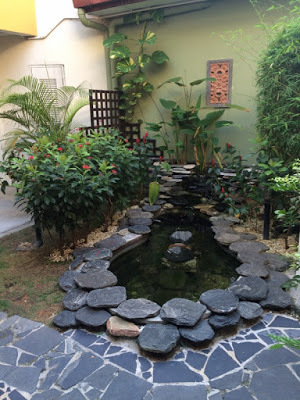
I connected in Dubai, and as I have seen on past trips to parts of Asia, they cap the boarding process with the spraying of insecticide.
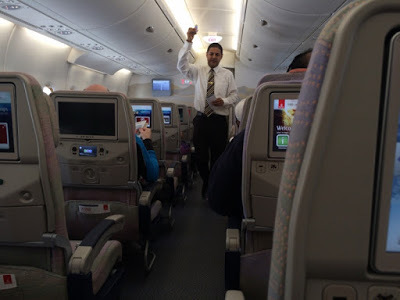
The Petronas Towers, the world’s tallest buildings from 1998 to 2004, were the tallest buildings visible from my hotel room. At night they look ghostly.
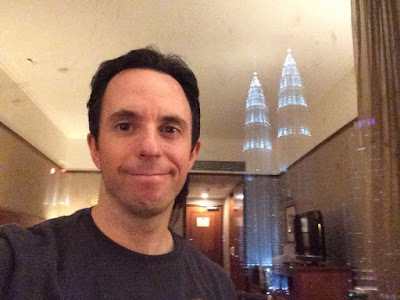
And unlike American skyscrapers, they don’t stay lit all night.
Inside one lobby in the towers, I saw an advertisement for a superhero symphony.
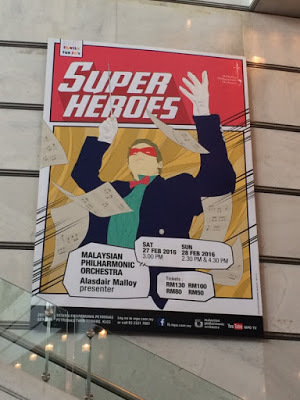
When I learned a place called Batu Caves was a 30-minute subway ride away, I could not resist. It’s one of the most visited Hindu shrines outside India. It’s also one letter off from my favorite of all caves.
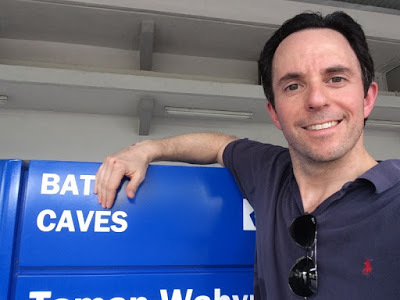
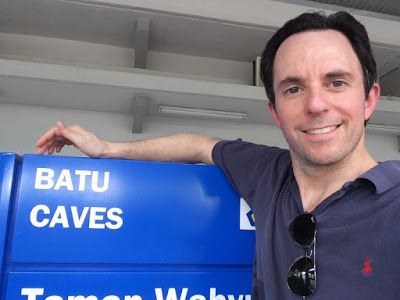
This area on the subway platform would warm the heart of any author (though in KL, everything is warm all the time).
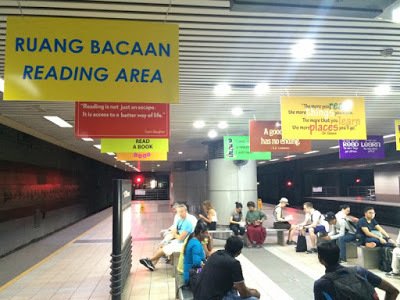
En route, I encountered a couple of signs that drew attention from other Westerners as well.
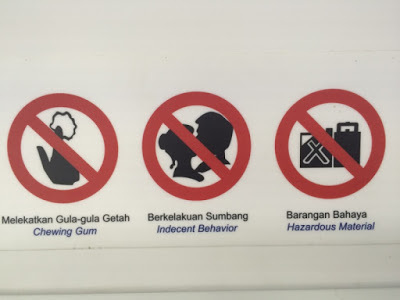
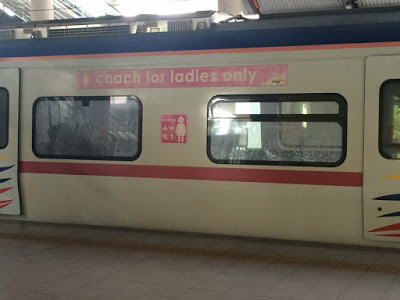
From inside the entrance of the Dark Cave (part of the Batu Caves complex), you can look into the distance and see the Petronas Towers.
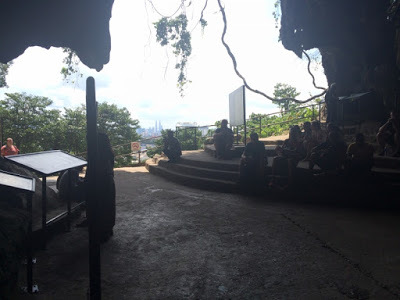
Views from either side of the biggest cave:
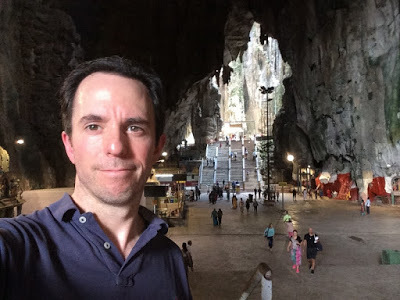
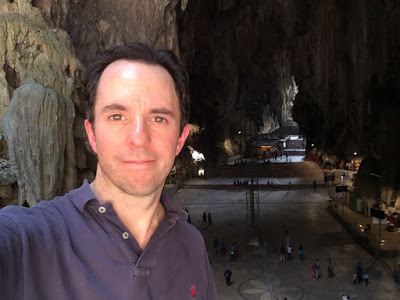
More glimpses of Batu:
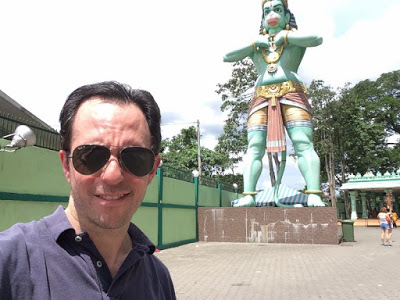
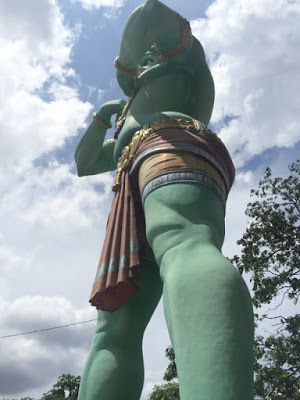
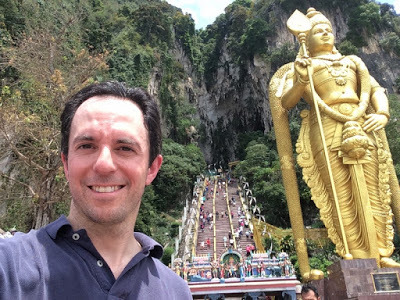
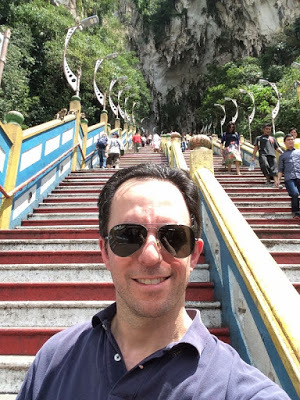
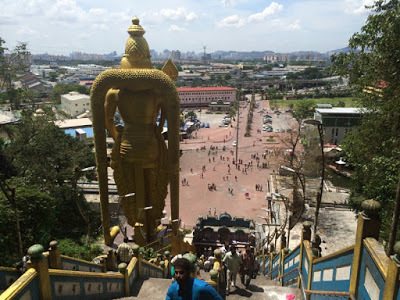
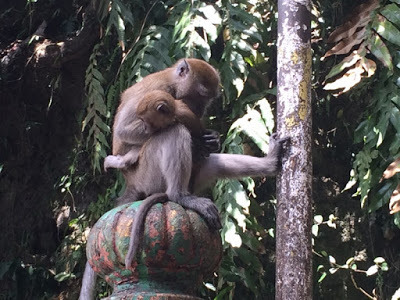
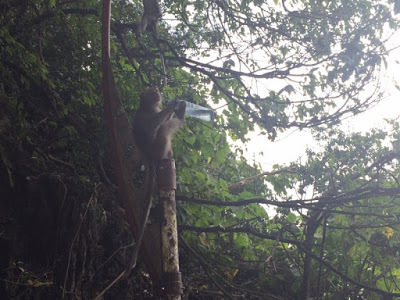
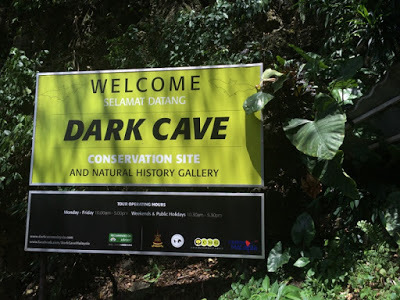
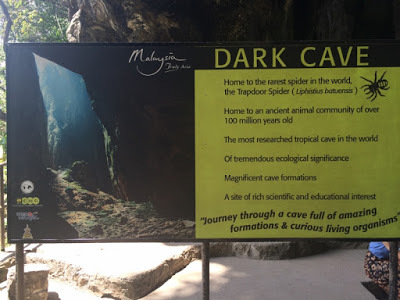
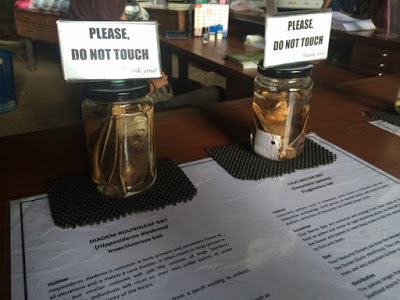
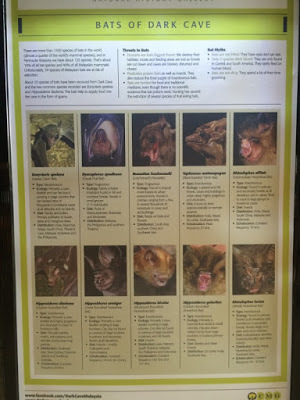
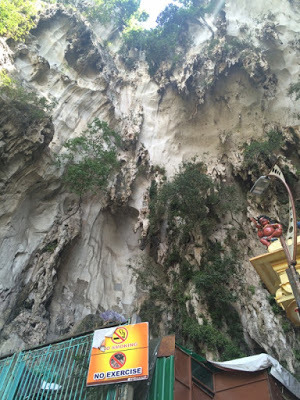
Passing a pharmacy counter back at the mall at the base of Petronas Towers, I saw a book you won’t find laying around your average CVS.
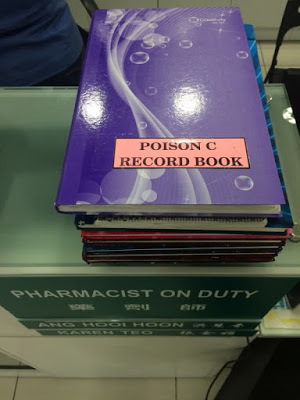
My favorite of their ‘80s hits is a tie between “Rio” and “The Reflex.” I didn’t know they run juice bars, too.
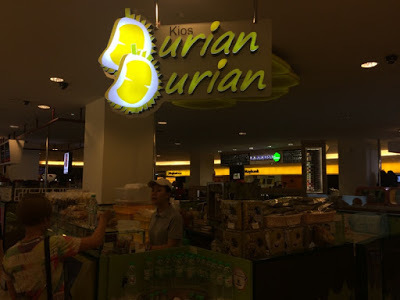
At the base of KL Tower (which resembles Seattle’s Space Needle) is the last remnant of what used to be on the site of KL: rain forest.
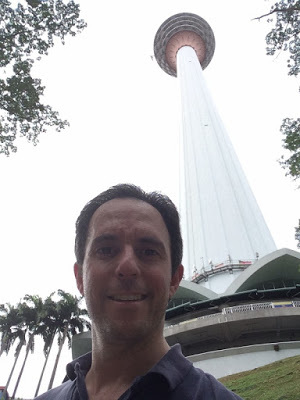
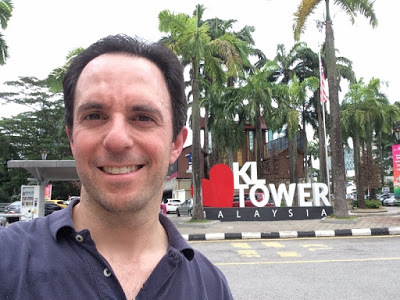
You can enter and wander freely. On the canopy walk throughout part of the forest, I saw a few others, but back on the ground, I was alone.
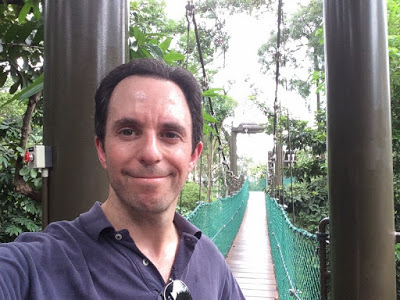
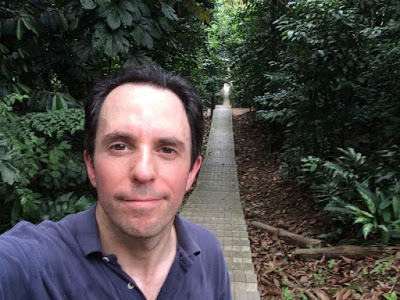
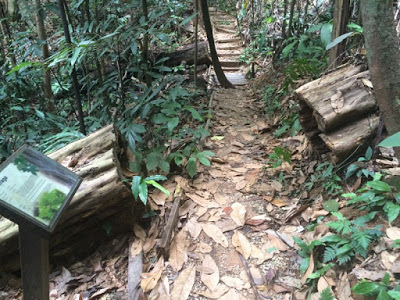
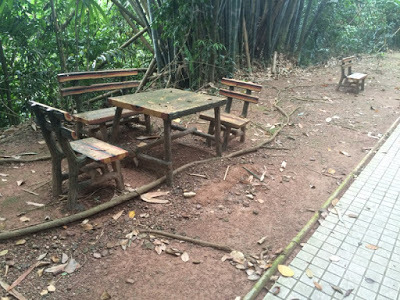
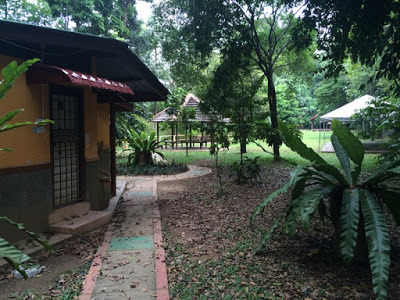
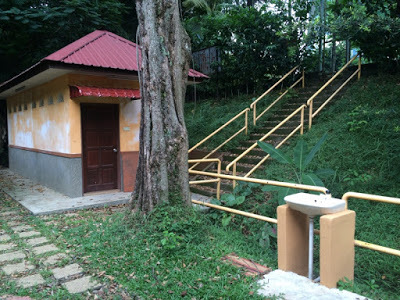
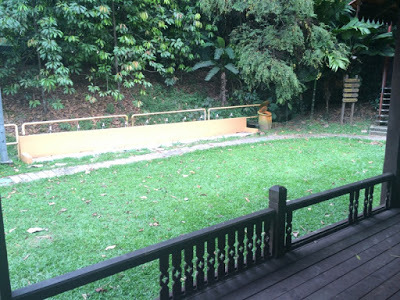
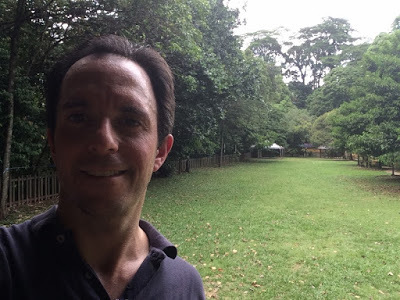
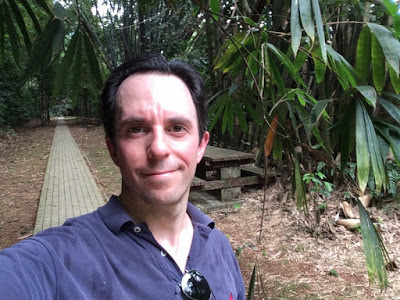
I found out the weird way that if you don’t exit by 5 p.m., they lock you in—and some people on the outside don’t lift a finger to let you out.
One guy (whom I believe was an employee of the park/grounds) sitting at one locked exit instructed me to “go around”—but I had no idea what that meant exactly, so I walked back about 20 minutes till I found the only other exit I was sure I could find. That was locked, too.
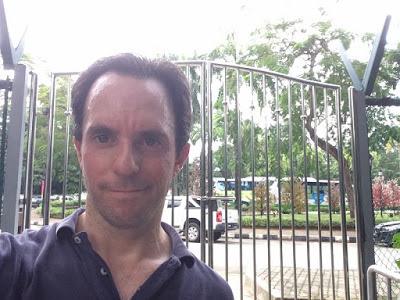
Two other surprised guys showed up on my side of the gate, and we all waited while someone went to find a key. After a short while passed with no sign of rescue, I considered climbing over and probably could have, if not for my hands being slick with sweat and the bars being metal. Luckily, the gatekeeper eventually did return.
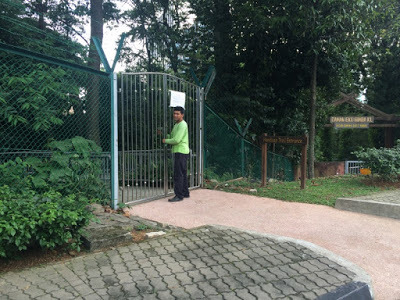
And all that was just Sunday.
I walked a lot farther than I realized.

The next day was my first of seven at ISKL. Another adventure begins…
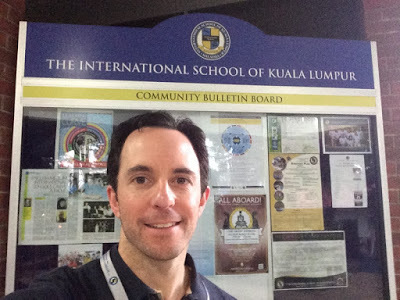
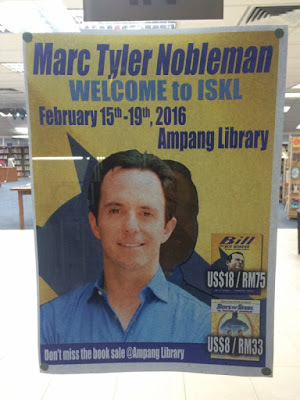
I hand-carried 76 books. By day three, I had sold them all but did not bring enough.
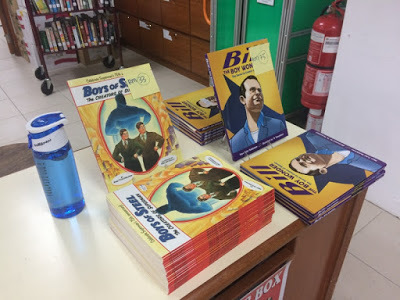
Thank you, ISKL for bringing me to KL, which I find easy and enjoyable to explore.
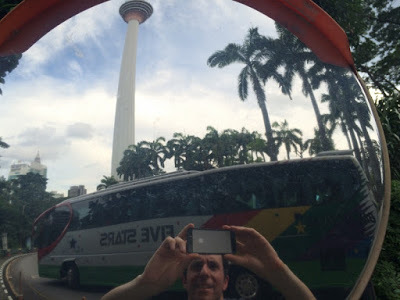
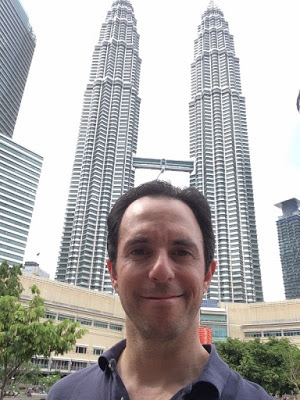

I connected in Dubai, and as I have seen on past trips to parts of Asia, they cap the boarding process with the spraying of insecticide.

The Petronas Towers, the world’s tallest buildings from 1998 to 2004, were the tallest buildings visible from my hotel room. At night they look ghostly.

And unlike American skyscrapers, they don’t stay lit all night.
Inside one lobby in the towers, I saw an advertisement for a superhero symphony.

When I learned a place called Batu Caves was a 30-minute subway ride away, I could not resist. It’s one of the most visited Hindu shrines outside India. It’s also one letter off from my favorite of all caves.


This area on the subway platform would warm the heart of any author (though in KL, everything is warm all the time).

En route, I encountered a couple of signs that drew attention from other Westerners as well.


From inside the entrance of the Dark Cave (part of the Batu Caves complex), you can look into the distance and see the Petronas Towers.

Views from either side of the biggest cave:


More glimpses of Batu:












Passing a pharmacy counter back at the mall at the base of Petronas Towers, I saw a book you won’t find laying around your average CVS.

My favorite of their ‘80s hits is a tie between “Rio” and “The Reflex.” I didn’t know they run juice bars, too.

At the base of KL Tower (which resembles Seattle’s Space Needle) is the last remnant of what used to be on the site of KL: rain forest.


You can enter and wander freely. On the canopy walk throughout part of the forest, I saw a few others, but back on the ground, I was alone.









I found out the weird way that if you don’t exit by 5 p.m., they lock you in—and some people on the outside don’t lift a finger to let you out.
One guy (whom I believe was an employee of the park/grounds) sitting at one locked exit instructed me to “go around”—but I had no idea what that meant exactly, so I walked back about 20 minutes till I found the only other exit I was sure I could find. That was locked, too.

Two other surprised guys showed up on my side of the gate, and we all waited while someone went to find a key. After a short while passed with no sign of rescue, I considered climbing over and probably could have, if not for my hands being slick with sweat and the bars being metal. Luckily, the gatekeeper eventually did return.

And all that was just Sunday.
I walked a lot farther than I realized.

The next day was my first of seven at ISKL. Another adventure begins…


I hand-carried 76 books. By day three, I had sold them all but did not bring enough.

Thank you, ISKL for bringing me to KL, which I find easy and enjoyable to explore.


Published on February 17, 2016 05:00
February 12, 2016
How I met Bill Finger
After the historic credit announcement of September 2015, Bill the Boy Wonder: The Secret Co-Creator of Batman artist Ty Templeton touched me deeply by creating this:
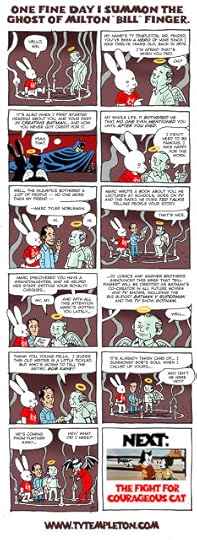 I included this toon in my announcement of the announcement, but it more than deserves its own post.
I included this toon in my announcement of the announcement, but it more than deserves its own post.
 I included this toon in my announcement of the announcement, but it more than deserves its own post.
I included this toon in my announcement of the announcement, but it more than deserves its own post.
Published on February 12, 2016 04:00



